#no idea why new people follow me if not from old infographic content
Explore tagged Tumblr posts
Text
"So clever&, why do you think people follow your blog?"
Obviously because I like to lull them into a false sense of security through 95% aesthetique reblogs before abruptly going for the jugular of their deeply rooted trauma because I myself am having Thoughts and Feelings
#sarcasm#no idea why new people follow me if not from old infographic content#people who have been here a while... you're innoculated from my Behaviors i think#personal
8 notes
·
View notes
Text
The Best 10 Animated Explainer Video Companies 2021- Alpasbox
Animated explainer videos are a great way to communicate ideas online. They're an excellent option for businesses that want to reach their target demographic, but don't have the budget for traditional video production. If you need help finding the best company out there, then this blog post is just what you need! In it, we'll discuss the top 10 animated explainer video companies and provide all of the information you'll need to help find your perfect match. Read on for more details!
Marketing agencies and businesses are constantly looking for new ways to introduce their brands with creativity. Explainer video companies come in handy when a company is at that point, providing gold standards of advertising or classics which can be relied on upon through time periods. However, if the marketing tactic becomes too old-fashioned it will become ineffective- as people grow tired of them over time.
A video is a great way to make your business stand out among the crowd and offer something fresh to customers. Short commercials, marketing videos, product demos, app introductions, or trade show videos – all of these may impress prospective customers even more if you amplify them with eye-catching animation.
If you want to outshine your competitors and create the best video advertising of all time, then why not consider hiring a company that’s specifically an animated explainer video production company? No one is better at challenging conventions in creative ways than these animation geniuses. Here are some examples from this year! Did we mention they have experience working for companies across industries with years of knowledge under their belts?
What are the criteria for choosing an explainer video company?
We know you're eager to see our list of the best explainer video companies, but first, we need to talk about what makes for a great animated video.
· Quality matters. It is important to pay attention to the quality of videos in a portfolio because it's not always easy for you or me as designers, but that simple factor- whether we like them or not - will be our best guide!
· Stand out from the competition with custom designs. If you need a unique and stand-out video that doesn't rely on templates, contact one of our animation companies today for your design needs!
· The best way to choose an explainer video company is by looking for one that has a detailed process, communicates well with its clients, and follows through on all the details. These companies will be willing to go out of their way in order to make sure you get exactly what you want from your video while still delivering quality work.
· Feedback from customers is key to ensuring the success of any company. Reviews can help you make a more informed decision about your business partner, and it's important that they are both genuine and recent!
· It is true that you get what you pay for. So, if a company has the cheapest prices on offer - don't expect to find your perfect piece of art with them! They are probably not skilled enough and must be using their low pricing as bait to draw in more customers who want something they can afford.
The best explainer video production companies will make your complicated ideas easy to understand. Check out this list of the top five and see who can help you with your needs!
Alpasbox :
Alpasbox is a creative agency that has been creating the best explainer videos for over Four years! They have won awards and are now considered one of the top innovators in animation. If you're looking to create an animated video, they will not disappoint with their work which includes captivating graphics and animations. Many people all around the world enjoy Alpasbox's high-quality product so if you want your company or idea brought alive through motion pictures then this is where it starts off at
Alpasbox explainer video production company's services:
Explainer Video, Corporate Video, Animated Explainer Video, Live-Action Explainer Video, Whiteboard Explainer Video, Product Explainer Video, App Explainer Video
What people say about them: "First of all, I wanted to thank you for the great job you've done! You really delivered what I was looking for. The video is awesome, even better than I expected!"
Explain Ninja :
Explain Ninja is an explainer video company and animation studio based at the heart of Poland, Warsaw. The team excels in producing different animations for startups like Google to iconic brands such as Atlassian and Codio with hundreds of award-winning videos since its foundation in 2013.
Demo Duck :
Demo Duck is a US-based company that helps brands grow their conversions and revenue by providing them with animated videos. Demo Dunk's animation captivates viewers, making it easy for businesses to convey complicated ideas in an understandable way.
Video is one of the most powerful tools to use in marketing and Demo Duck knows that better than anybody. Their portfolio includes work for big brands like Netflix, Dropbox, Crazy Egg, and others- just check their videos!
Wyzowl :
https://vimeo.com/359087395
Wyzowl is an animated video production company headquartered in the UK. In 2020, they have shown exceptional results in global competition and received many awards. What has amazed us indeed is their number of videos- 2500!
The team at Abstract Pixel has been producing animated videos since 2009, always striving for creativity and high quality. They have worked with 40 countries worldwide - the majority of their clients are located on either coast in the US but they're available to work internationally as well!
Studio Pigeon :
https://vimeo.com/396890878
Studio Pigeon is the leading provider of high-quality animated content with headquarters in Warsaw, Krakow (Poland), and Riyadh (Saudi Arabia). They specialize in explainer videos, cartoon series, commercials motion design, and animation.
Studio Pigeon provides a wide range of services including Animation for Explainer Videos; Cartoon Series; Commercials Motion Design & Animations 2D + 3D animations Visual Content Marketing Advertising Infographics Post-production
Epipheo :
https://vimeo.com/439265790
Epipheo is a video production company that has been creating videos for businesses and organizations across the nation since 2009. The studio's work includes animated courses, commercials, branding projects, educational films of all sorts, as well as various other types of communication content such as e-learning modules or trade show presentations.
Ephipeo produces visually stunning videos for their clients. They are noted in the industry because of how they highlight client peculiarities and research them to make sure that each video is tailored specifically to your needs.
Switch video :
Switch Studio is a Canadian animation production studio that specializes in 2D animations, whiteboard explainer videos for IT companies. They have managed to make more than 1,200 videos for numerous clients in 15 countries and 15 languages and among their customers is IBM.
Switch Studio's main goal is to unlock the full potential of their customer's businesses through high-quality animated video productions with specialized expertise such as storyboarding or voice-over recording at affordable prices!
Common Craft :
If you are looking for a way to introduce your product or service in an interesting and engaging manner, there is no better option than animated explainer videos. Common Craft has made it easy by providing templates with downloadable visuals that make creating the video simple! It's not just about introducing; Elite also offers ready-made animations to help businesses get their message across as quickly and succinctly as possible.
Common Craft is a company that provides easy-to-understand videos for difficult topics like physics and history. They also offer templates, lesson plans, and other educational tools to make it easier on both students and professors alike.
Yum YumVideos :
Yum Yum Videos is a top global animation studio that specializes in high-quality work, including award-winning animated videos. They have more than 20 years of experience and their clients include international brands such as Wal-Mart, Docusign, Fox Entertainment Group Red Bull Media House McKesson among others.
The animation style of Yum Yum Videos is adorable and minimalistic, which makes it easy for viewers to identify the works. They offer many revisions that are customized as well in order to best suit your needs.
Thinkmojo :
https://vimeo.com/393751190
Thinkmojo is the best explainer video company on the market. It has gained trust from some of today's biggest companies like Google, Twitter, Slack, and Zendesk to name a few. ThinkMojo believes that videos are your body language in this digital age so they use them as one way for brands to express their ideas better than ever before
What is the best price for an explain video?
When it comes to creating an explainer video, you need a production company that can bring your brand's message and identity into the digital age. Luckily for you, we have listed 10 of the best companies on our list so far! These firms are all unique in their approach but do offer varying price ranges - some as low as $350 or high up to $35,000.
With so many different styles of videos to choose from, how do you know which is right for your business? The price also varies depending on the length and content. Keep in mind what information it should contain as well as its total running time before deciding!
When you are looking for a top-notch animated explainer video, don’t expect the best to come cheap. We advise having a budget of $3,000 – $10,000 in mind when hiring one of our professional companies from this online directory.
Conclusion
In this article, we have collected some of the best explainer video companies. We include their size and specialization just in case you need that information to make a decision on which one is right for your business or project. It's important not only to consider quality but also style because each company does things differently than others so it may be necessary to view portfolios first before making an order as well as checking reviews from past clients who used them before deciding if they are the perfect fit! You can contact any company with questions about what they offer too; most of them will gladly answer all inquiries and even give suggestions based on previous projects like yours.
Don't let your brainstorming go to waste. Alpasbox has answers for you!
We're here at Alpasbox, and we're ready to help you with any of the questions that might be going through your mind about how to find a good animation studio. With our selection on this page as well as some information from us, hopefully, it will lead you in the right direction while having all those ideas flying around in there somewhere too!

6 notes
·
View notes
Text
RECENT NEWS, RESOURCES & STUDIES, July 19 2020

Welcome to my latest summary of recent ecommerce news, resources & studies including search, analytics, content marketing, social media & Etsy! This covers articles, podcasts, videos and infographics I came across since the late June report, although some may be older than that.
I‘m still working on Etsy search testing and a few new blog posts and pages for my website, so it is still difficult for me to get this summary out more than 1-2 times a month. All suggestions on solutions to my time crunch are welcome.
If you have an questions, comments or suggestions about my Tumblr or my blog, please contact me here or on my website. I’d love to know what you think!
TOP NEWS & ARTICLES
Latest change from Google: the free Google Shopping listings will now show up in US organic search as part of product knowledge panels. Unfortunately, since they are only doing this for product knowledge panels to begin with, it likely won't help handmade sellers, but could be useful to sellers of vintage & supply items that are known products that will have a knowledge panel. It may be a sign that they are planning on moving free ads to more Google "surfaces" over time, however. Note that it appears that all product knowledge panel ads will be free starting this summer (US only), so that means that any Etsy paid ads for these types of items will become free ads that you won't have to pay EOA fees on if you get a sale. Google claims the free ads are bringing more searcher engagement to Shopping.
Amazon announced they will begin to show US sellers’ business name and address on the Seller Profile page as of September 1. The same requirement already exists in Europe, Japan and Mexico.
The USPS will no longer be delivering mail as promptly every day, to cut costs. This potentially affects anyone shipping to a destination in the United States.
How 7 different companies grew profits during the last recession - there will still be business opportunities during the upcoming recession, but you have to be positioned to take them.
ETSY NEWS
Etsy Labels no longer offer USPS international shipping options for all packages under 4.4 pounds other than Canadian orders, replacing them with the Global Postal Shipping Program (GPSP). Many US sellers dislike the GPSP, and have moved on to outside providers that integrate with an Etsy shop and other services, such as Pirate Ship, Shippo, Stamps, and Shipstation.
The quarterly category & attributes updates are limited to face mask & hand sanitizer attributes for July. Etsy also made some other minor updates recently, including allowing us to set a message auto reply for up to 5 days.
You may have noticed that Etsy is really pushing Etsy Ads on sellers right now, despite the numerous complaints about the average cost per click becoming far too high last year. I’ve turned mine off permanently, but if you are interested in trying them or fine-tuning them, Etsy released an article and a related podcast with a transcript.
Louisiana and Mississippi have been added to the list of states that Etsy collects sales tax from.
Etsy raised fees on Reverb to 5%, “to make further investments on behalf of our sellers.”
Etsy will release the second quarter results on August 5. We already know that April and May were record-setting, and June was also probably pretty good.
The site has continued to receive decent media coverage for the mask initiative; Etsy is mentioned in several articles/broadcasts a day as a place to get masks, including stylish ones. This article briefly interviews a seller and looks at what Etsy will do next, as the mask demand peak might be over.
Now that people think of Etsy for things like face masks, Etsy is continuing to market itself as a place to buy everyday items, something it shied away from for a few years. (Remember when Etsy was all about “owning special”?) They’ve added “Everyday Finds” links & Editors Picks pages, and have published tips on what pandemic shoppers are looking for. (Note that the year over year values compare this April to last April, and so were during peak lockdown for the US.) “Keeping surfaces clean is top of mind these days, and shoppers are searching on Etsy for many types of cleaners, from all-purpose scrubs to washable sponges...134% YoY increase in searches on Etsy containing “ceramic sponge holder.”...”74% YoY increase in searches on Etsy containing “mug”...”352% YoY increase in searches on Etsy containing “diy”.
Please correct me if I am wrong, but this page on the search and ads algorithms appears to be relatively new.
SEO: GOOGLE & OTHER SEARCH ENGINES
The sea change in online buyer behaviour during the pandemic may mean that you need to update your keyword research. Keyword volumes have changed, some very dramatically. For example “‘adult bikes’ shows a massive upturn.This represents over ten times as many searches for this term compared to just under a year ago. If you projected this back in 2019 you’d probably be laughed at.”
Speaking of keyword research, if you need a refresher on why you should do it and how to approach it, here is a recent article.
There are many different ways to get backlinks; here are a few that are pretty easy [video & text].
Are longer blog posts better for SEO? Not necessarily, as long as you cover the topic well. The exception is that blog posts under 300 words are usually not worth writing.
Most SEOs think there was an unannounced Google update around the third week of June. Some are reporting that sites that specialize made gains, as opposed to those who have more general material. That same study reports Etsy had one of the largest traffic increases, but not as much as Pinterest (I’ve been seeing a lot more pins when Googling lately, so this seems likely.) Government websites also seem to have received better visibility. “As Google has described in their document on how they fight disinformation, they describe that their systems are designed to prefer authority over other factors “in times of crisis”. If this truly is related to what we saw happen in June, these changes could possibly be reversed once the worldwide pandemic situation improves.”
Bing released a few basic tips on how to use its keyword planner.
(CONTENT) MARKETING & SOCIAL MEDIA (includes blogging & emails)
TikTok has moved out of Hong Kong, while the US government may be looking at banning them, following India’s move on July 6. With TikTok in peril, many people are now downloading its competitor Byte.
If you use Facebook for your business, please read up on the changes required to comply with California’s new privacy law.
Instagram is now testing an Instagram Shop tab, which allows users to filter by category.
Twitter is planning on starting a subscription service, but deleted some of the details from the job listing just hours later.
One of the results of the big Twitter hack on July 15th was Google removing the Twitter carousel from its search results.
Pinterest searches involving Christmas started way earlier this year, with a 77% increase YOY in April. “That includes a 3x increase in searches for “Christmas gift ideas”, while other queries like “holiday recipes” and “Christmas” were up more than 90% and 80% respectively.” These are good stats for marketers to have, helping us decide when to release and promote new products.
ONLINE ADVERTISING (SEARCH ENGINES, SOCIAL MEDIA, & OTHERS)
Spending too much on Facebook ads? Here are some common mistakes and some suggestions on fixing them.
If you already know that ROAS stands for “return on ad spend” then some of this article may be old news to you.
STATS, DATA, OTHER TRACKING
If you are using Google Shopping with your website, be aware that the Google bots may be inflating your abandoned cart rate.
Google Analytics can help you track the effects of changes to your website, or other business conditions. You can also get alerts when certain types of events happen, or when traffic is abnormal.
ECOMMERCE NEWS, IDEAS, TRENDS
Walmart is expected to launch Walmart+, similar to Amazon Prime, this month. But note that while many brick & mortar businesses are now doing a lot more business online, it is more expensive for them.
For those of you who use Stitch Labs, they have been purchased by Square, and the existing services will likely be cut in 2021.
Deja vu for Etsy sellers - eBay was apparently offering incentive payments for signing up for their new Managed Payments system by mid-July. (Etsy did the same with its Etsy Payments system, but only for Americans.)
Is Amazon Handmade as good for small makers as it claims? Maybe not. If you sell on Amazon, consider these strategies to protect your core business from being swamped by the big A.
Wix has introduced an ecommerce version with a lot more options and integrations.
Shopify’s new “Shop” app has some good features but also some issues. [podcast & edited transcript]
BigCommerce filed to go public, and added Ayden as a payment option. More details on the Ayden move here.
Did you know there are sites you can use to sell your ecommerce business? Here are 10 of them.
BUSINESS & CONSUMER STUDIES, STATS & REPORTS; SOCIOLOGY & PSYCHOLOGY, CUSTOMER SERVICE
US ecommerce sales are now expected to grow 18% this year, while overall retail is predicted to be down 10.5%. “In a pandemic economy, consumers have gravitated toward trusted and reliable retailers. As a result, we can expect the top 10 ecommerce retail businesses to grow at above average rates (21.8%). Amazon will gain US ecommerce market share this year, while Walmart's accelerating ecommerce growth will take it to the No. 2 position for the first time.”
Fear of missing out (FOMO) is a factor you can use to drive sales; here are 6 tips.
Generation Z is acutely attached to internet use, and is more likely to be planning on starting their own business than any other generation.
MISCELLANEOUS
It’s possible that the increase in people working from home will lead to more work hours and therefore more burnout.
1 note
·
View note
Text
Thoughts on House of X#2
I fell way behind on writing these even as I devoured each issue, so I thought I might as well knock these off as the HoX/PoX miniseries come to an end and the “Dawn of X” looms over the horizon. (Also I did a re-read recently and it got my mind buzzing.)
So let’s get into it!

Moira’s Ten Lives:
It turns out that, like everyone else, I was sort of right/wrong about time travel shenanigans. It’s technically a semi-stable time loop, but I’m not about to quibble. (Incidentally, on a re-read one of the things that’s been really impressive to see with the benefit of hindsight is the way in which Hickman et al. top each issue with the newest high concept or reveal, like some mad plate-spinning act.)
Here’s how the individual lives break down:
Life 1:
Because everything in this life takes place prior to the activation of her mutant gene (which, talk about a hell of an additive retcon), Moira’s first life is a romanticized, bucolic portrait of innocence not corrupted by worldly knowledge. The emphasis is strongly on family and nature (note the tree motif, which isn’t as prominent as the tower motif but still) as opposed to scientific pursuits.
On the other hand, you definitely get the sense that the perfect nature of this life is a distortion caused by nostalgia, as we’ll see in the next life.
Life 2:
Moira reincarnates for the first time with full knowledge of her previous life, which for all that HoX/PoX has been analyzed through the lens of both Christian and Jewish theology, can’t help but draw from Hindu and Buddhist thought.
One key aspect of her power is that Moira is given an enormous developmental leg up, being born with all of the skills of a grown adult. Suprisingly, we don’t actually get to see Moira make much use of some of the broader implications of her mutant power.
As a good scientist, Moira uses observation and experimentation to prove to herself that her memories are real and that she can change the future through her actions, two critical pieces of information.
Speaking of Buddhism, Moira’s “curse” concept is tied to the Second Noble Truth, that suffering comes from attachment. In this case, Moira’s problem is an attachment to her memories of her idealized first life: when she meets Kenneth Cowan for the second time, the emotional connection isn’t there because her foreknowledge of her first life changes her perceptions.
At the same time, I wonder how much of her reaction to this upheaval is due to her realizing that her first life wasn’t as perfect as she thought it was (the flaws she focuses on), or that she herself has changed and isn’t content to live and die as a rural schoolteacher.
In this timeline, Charles decides to come out of the closet as a mutant on national television, which is a different tack to how he’s approached pro-mutant activism in the past, although there is a common theme of putting his faith in public debate. Sadly a faith that will be broken.
Despite her misgivings about her own mutant gifts, Moira decides to fly to America to meet Charles...and dies in a plane crash. I wonder how much of her heel turn in life 3 is due to the Kenneth Cowan issue and how much of it comes from her experiencing violent death for the first time?
Life 3:
In Moira’s third life, she turns sharply away from Charles (nicely symbolized by her turning away on a pub stool) to try to cure the mutant gene, which brings her face-to-mask with Destiny, who is the closest thing that this issue has to an antagonist (at least in the sense an outside force acting on Moira and changing her behavior).
The conversation between them is split in two: in the first, Destiny does a good job of laying out why narrative of individual choice/consumerism don’t really work with regard to mutant cures, because of pre-existing structures of power and inequality that will turn an option into a mandate. Something that Whedon’s “Gifted” arc and X3 should have maybe mentioned.
(Incidentally, even before we got the later infographic from Powers of X #4 about mutant genocides, I thought this didn’t bode well for Wanda Maximoff.)
After setting up a Prisoner’s Dilemma situation - if you don’t change your behavior, this scenario will keep recurring - Destiny then gives us the next big reveal of the issue. Moira’s powers of resurrection only give her ten or eleven lives, that there is a way out of the cycle of endless rebirth if she makes the “right choice.” (Word is still out on the other aspects of the Eightfold Path.) I don’t know what the eleventh signifies - after House of X #5, I saw a lot of people suggesting pod-rebirth as her eleventh life, but I dunno.
However, I did spot something this time: Destiny “see[s] ten lives...eleven if you make the right choice at the end.” This may be me reaching, but it suggests that Destiny knows already that Moira isn’t going to get it right in lives four through nine, but isn’t telling her. Which, given the immense potential involved in combining their powers, suggests that it’s not just about Rube Goldberging her way to the Good Ending but rather that Moira has to experience her defeats personally in order to grow into the person who would make the right choice.
Life 4:
Having received a fiery “swift spiritual kick to the head,” Moira makes two changes in her life. First, she begins to approach the question of mutancy from a systems perspective - although I have some significant issues with Hickman’s evolutionary biology. Second, she looks deeper past Charles Xavier’s “confidence...arrogance,” to see the real Charles beneath, and the two fall in love (which makes the second time in her lives).
The result seems to be the 616, breaking down into the Gifted Years (the Kirby/Lee years), the Time of Hate and Fear (the All-New X-Men given to us by Claremont et al.), and “the lost decade,” which given the associated panel is a pretty clear slam on the last ten years of X-Men storytelling, most pointedly Avengers vs. X-Men.
This page (p. 17) has made me somewhat out of step with a lot of folks who’ve been arguing online that Moira’s sixth life must be the 616 - a trend we’re going to see repeating.
Regardless, this timeline is the first to end with Sentinel genocide, resulting in Moira for the first time seeing the dystopian dilemma. Much of what follows is a series of unsuccessful iterative attempts to solve this dilemma.
Life 5:
In her first go, Moira decides to see if accelerating the process will work, showing Charles what happened to his dream in her past lives. Hickman’s use of the term “radicalized” is key here to understanding what’s going on with Krakoa in X^1, because as Moira learns (and Charles will learn), separatism alone will not do the trick. Mutants got an 11-year head start to build up their defenses, and the Sentinels came anyway.
Life 6:
Because this life remains completely redacted, the fandom has gone absolutely nuts in speculation. One common speculation I’ve seen is that the X^3 timeline is Life 6, which I find quite puzzling. The reveal in Powers of X #1 that Cylobel is stuck in Nimrod’s femtofluid database is strongly suggestive that X^3 is Life 9, unless we’re going to say that in alternate timelines in which so many variables change, there’s always going to be a black brain hound mutant who looks identical to Cylobel and who dies in the exact same way. Which strikes me as falling afoul of Occam’s Razor.
Life 7:
Here’s where we really start zeroing in on the dystopic dliemma, as Moira tries to forestall the inevitable by eliminating the Trask bloodline. It doesn’t work because of the whole idea that AI is a discovery not an invention, and as a result Sentinels will always come about and the only thing that can be changed is the name of the person who’ll discover them.
Here is where Hickman’s obsession with mechanical vs. biological transhumanism (and/or singularities) really come into play. If you’ve read his book Transhuman (which I don’t necessarily recommend, as it comes with some rather nasty sophomoric undercurrents that have aged very badly in the last ten years), you’ll know that Hickman considers biological transhumanism to be superior to the alternative. Something to keep in mind when thinking about mutants vs. the man-machine supremacy, mutants vs. the technarchy, etc.
Interestingly, we never learn what happened to Xavier or the X-Men in this life.
Once again, Moira is “radicalized” by the seeming inevitability of robotic genocide, although it’s noticeable that her focus is shifting from humans to their creations.
Life 8:
Her solution is to go to Octopusheim and ally with Magneto, presumably because the Master of Magnetism is her first bet to go up against the mutants.
Magneto reacts to “the good news” with thermonuclear war, and gets curb-stomped by a combination of the Avengers, Fantastic Four, and X-Men.
Important note that by this point, Moira dismisses the idea of any great good beyond that only of mutants, and we go for another round of radicalization.
Life 9:
At this point, Moira decides to ally with Apocalypse out of desperation, presumably because Apocalypse is a revolutionary who can’t be killed as easily as Magneto can.
Although we didn’t know it at the time, this is X^2 (and I think X^3) as well, and while Apocalypse’s power levels allow him to prosecute a war “without end,” it doesn’t solve the strategic stalemate.
Life 10:
I don’t know what the two black panels suggest; it’s quite possible that they’re just pauses for emphasis.
In her tenth life, Moira takes a step back and focuses instead on “all the old ways of thinking.” Here, I think we see a preview of the Krakoan solution: mutant unity will unlock synergies of cooperation that were not possible while working with limited mindsets and only a part of mutankind.
Notably, we don’t know when Moira or anyone else found out about the possibilities of Krakoa and mutant biotechnology - we know some of it existed in Life 9 because we see Krakoan flowers being used, but we don’t know if Moira encountered it earlier or whether the higher order stuff was in use. I somehow doubt the resurrection system was intact, because it would seem to make Mister Sinister’s breeding program largely irrelevant.
Once more, we return to Powers of X #1, as we now know what Xavier learned from Moira’s mind.
Infographics:
The whole circle wrap-around thing is very evocative of other signs we’ve seen (on Cerebro when Xavier uses it for various higher-order stuff, on the Librarian’s face, etc.), but it actively makes the map harder to read, which I think is the point.
(Also, while I’m complaining: Comixology is not well set up for these large-scale infographics, because it keeps crashing on me when I try to zoom in. Very annoying.)
Note: earlier lives are more leisurely, things more spaced out, and then the pace accelerates as things get more intense.
One interesting difference between Life 4 and 616 canon: Moira and Xavier marry when she’s 23 and establish the Xavier School 12 years later.
Life 5 is interesting, because we’re seeing repeated themes of Moira in comas, even when it might not be necessary. For example, what’s the dramatic purpose of having the two Sentinel attacks?
In Life 7, I noticed that Larry Trask isn’t killed with the rest of his family. Is it because he turned out to be a mutant?
Life 8 is the first instance where I think the initial panelling let us down. The original one-two punch heavily implied that Magneto was defeated on his first attack on Washington D.C, but here we learn that he ruled America for eight years before being defeated and killed. (Incidentally, this suggests that the visions he’ll have of his failures don’t include this life).
As other people have noted about Life 9, Xavier and Magneto are killed in Years 19 and 21 respectively, which makes it easy to rule out their appearances as happening in Life 9. Also, it’s significant that the first horsemen aren’t on earth (almost certainly on Arakko/No-Place).
Life 10 including Moira’s marriage to Joseph McTaggert despite presumably knowing from earlier lives that he would be abusive suggests that Moira may well have gone into the marriage because she needed Proteus to form the Five. Not sure how I feel about that. Finally, I’m a bit puzzled about what the schism was and whether it was genuine vs. feigned (after all, Moira is faking her death, so there’s plenty of skullduggery going on).
13 notes
·
View notes
Text
Wealthy Affiliate Review – Don’t Try It Until You Read This!
There are many ways to build an online business. Numerous programs, too, that help people get started on their internet entrepreneurship. Wealthy Affiliate is one of them and among the most popular. It has been around for more than a decade now and still attracting thousands of people who wish to become online marketers. Most probably, you landed here because you wanted to know more about the platform; how it operates and if becoming a member is worth your time and money.

If that’s so, you’re in the right place. Reason? This post is a comprehensive Wealthy Affiliate review- and one that’s written from an honest viewpoint. By the end of the read, you will have learned about what Wealthy affiliate offers, how to join, the good and the bad about them, and so on. In short, everything Wealthy Affiliate. Let’s start by understanding what the program entails.
What Is Wealthy Affiliate?
It’s an online platform that trains people on how to become affiliate marketers. It’s also a business community where successful marketing gurus answer the questions of beginners. Meaning that apart from the training, members also get the opportunity to seek the help of experienced marketers. That’s in addition to being provided with tools that are necessary in the online marketing industry such as website creation, keyword research, website hosting, and more.
Wealthy Affiliate was founded in 2005 by two buddies, Kyle and Carson, and it aimed to help bu
dding internet entrepreneurs create and run online businesses successfully. What they did was come up with training materials and a website through which to offer the training. The site has so far helped thousands of ambitious people from all over the world realize their dreams, with current statistics showing membership of more than 1 million individuals.
Before we delve into what Wealthy Affiliate offers, it’s good that we talk about affiliate marketing; what it provides and the prospects if you decide to invest your time and money in the business model. That’s for the benefit of those who are new to this favorite way to earn money on the internet but which requires adequate knowledge and skills for one to succeed.
So, what’s Affiliate Marketing?
In basic terms, it’s a type of business where you earn money through using the internet to promote other people’s products- whether physical or virtual. You do that by creating a website on which to advertise the products, enrolling to become an affiliate marketer, and using various means to bring buyers to your site. You then get paid a commission for every sale that’s made. The more the sales that originate from your website, the more the amount that you make.
Affiliate marketing is one of the most effective ways to get money using online ways. Done right, it has the potential to earn you unlimited amounts of cash. It can even become your single source of income, enough to make you leave your day job. Many internet entrepreneurs are involved in it and already earning handsomely. The most successful earn 7-figure incomes doing nothing much than writing content that advertises a particular product or products.
To become an affiliate marketer, some skills are essential. You need to know how to set up a website, promote it for traffic, and so on. That’s where Wealthy Affiliate membership comes in- to equip you with the knowledge to start a successful affiliate marketing venture. If you’re into online marketing, you already know the amount of work involved and how you need someone to hold your hand for you to succeed. My personal experience in the industry has taught me many things;
First, I came to realize that patience is paramount. I also found out that you need to keep up to date with what’s happening in the industry so you can easily and quickly adapt to any changes that come up. Determination and hard work are also essential. Fainthearted marketers rarely make it, and instead, are likely to give up midway.
Maybe you’ve wondered why many of the people who enroll for Wealthy Affiliate membership succeed in their online marketing ventures. Also, why most Wealthy Affiliate reviews tend to be favorable. I believe the secret to be the training offered there. It encompasses all the requirements I’ve described above and much more, which brings us to the next part of this review.
What’s Offered at Wealthy Affiliate?
As we have already seen, Wealthy Affiliate is both a training center and an online community. They also provide you with the resources to set up your online business In a nutshell, the platform uses a consolidated approach to help people get into the world of online marketing (great news if you’re not experienced in the field of internet businesses) How have the founders managed to do that? On sign up, you’re trained on how to get started and given the necessary website building tools to take your first site off the ground.
Because everything happens there on the platform, you never have to look for any services from outside. Domain registration, hosting keyword research or even site monitoring tools are all offered. Website security is also provided. Website backup, too, and a lot of other necessary resources. The features you get access to depend on the membership plan you opt for, though, as we shall see later. However, even the most basic or free plan is enough to get you going, especially if you’re a newbie and testing the waters before committing fully.
Of all the affiliate marketing sites I have come across, I should say that few- if any- come close to offering what Wealthy Affiliate does. I mean, how many trainers can help you to start a business by providing the resources and tools you need and supporting you throughout the journey. A majority of them will only offer the basic training then leave you to your own devices. Besides, few can do that for free.
Let me give you a glimpse of what happens with many internet marketing training programs. Most don’t follow up on you let alone help you create the first website. What then happens is a struggle to find a footing by setting up a blog on your own and, in most cases, not doing it right. You end up with a poorly performing website that gets no meaningful traffic. The result? Your affiliate marketing business ends there. A sad situation, especially if you had paid for the training.
That doesn’t happen with Wealthy Affiliate. It’s a different training center altogether and one that’s built on a strong foundation of a business-like and professional approach to the whole idea of affiliate marketing. I find their way of doing things unique and useful in every way to help you succeed. They don’t leave your side until you’ve set the ball rolling and created your online presence. In what ways does it ensure that, you may ask? They use several means, and which I’ve described here.
1. An In-depth Training in Affiliate Marketing
I should say the training offered at Wealthy Affiliate is one of the most detailed you will ever find. The many years the company has been in the business (since 2005) should have given them enough experience to produce a program that covers all marketing aspects. It’s should be no wonder then that many of the Wealthy Affiliate reviews on the internet are mostly positive.
The training consists of text as well as video. These are added continually creating one of the most extensive databases of training content on internet marketing. As a member, you get access to the videos and text depending on the plan you’ve chosen. Either way, the training resources are crafted to help you start out. And if you’re already an experienced marketer, help you refine your marketing strategies to become even more successful. The first or beginner lessons (and which are essential if you’re just starting out) include the following:
A total of 120 lessons that cover more than twelve courses. The educational scope of the lessons touch on
• The basics of internet marketing
• How to set up a functional website
• How to research keywords and write relevant content based on them
• SEO to rank your site high in the results of different search engines
• How to incorporate infographics into your website
• How to set up ads
• The ways to improve conversions through referrals
• The essentials of social media advertising
• Creating useful and relevant content for your affiliate marketing site
… And much more.
What’s good about the content of Wealth Affiliate training is that it’s always updated to reflect market changes. That means you will not be subjected to old marketing tricks or strategies that may not work in today’s internet situation. Additionally, the material caters for both beginner and intermediate marketers. However, there are the advanced training materials and content that you can only access when using the paid for plan.
How do You go About Training on Wealthy Affiliate?
The training is progression-based. The interface allows you to finish one module before proceeding to the next, which help you to keep track of your progress as well as provide for orderly training. The individual lessons are composed of text and video. Text forms the biggest part of the content with videos being incorporated only when they’re a necessity.
The length of text in each lesson varies from 200 to 2000 word depending on the scope of the topic. If you’re not used to reading lengthy content and prefer watching videos instead, you may find some of the lessons overwhelming. But they come in different lengths, and you need not worry about that too much.
2. Help With Creating a Website
Website building is another of the many offers that members of Wealthy Affiliate are entitled to. For most people, setting up a website to become an affiliate marketer is one of the things that stand between them and success. It isn’t an easy task to create one from scratch- what with the domain name to purchase, the hosting to pay for, and so on. With Wealthy Affiliate, you do not need to worry about all that. The platform offers you an easy way to do that and you get your site up within a few minutes.
They use SiteRubix, a platform they own that helps members create a website or websites without having to seek any of the services to do so from other companies. This is the procedure that gets you a fully functional site within no time at Wealthy Affiliate.
• Find the menu to create a website
• Choose and enter the name of your website( you will be asked to either use an existing one or register one there and then)
• Enter its URL
• Choose a theme from among the many offered. A theme determines what your website will look like and you can choose the one that goes well with your product’s niche. Wealthy Affiliate uses the free WordPress layouts which means you have access to more than 3000 of them.
• Hit the “create Website” button, and that’s it- your website will be up and running with no time. Wealthy Affiliate does all the hard work to set it up which can be quite helpful if you’re a newbie.
• As soon as the platform has completed building your website, you’re provided with a username and the password to log in.
Once you’ve completed the steps to own a site, the next one is writing content and posting it there. You can also change its look to match your preference. The good thing about it is that you do not need to know any coding, and neither do you need previous experience regarding the design of websites. The niceties of Wealthy Affiliate don’t end there. Among the other benefits of setting up a website through the platform include the following.
• Domain Registration- you won’t need to buy a domain name to start your site, the platform offers that.
At the cost of 14 dollars for the registration, Wealthy Affiliate happens to be cheaper than what most domain registrars ask for. Besides that, the process is pretty easy and fast, which means a better experience if you have no prior knowledge about it. What’s more, you get free domain email to use with your website.
• Hosting- they host your website. You do not need to go scouring the internet for a company that offers the service, and which can be overwhelming if you’re a beginner. The hosting they provide comes with many great features. It’s secure, steady and fast; you get SSL certificates at no cost to you, spam blocker to protect you from hackers, and more. The platform’s hosting also offers a fast connection that improves user experience and search engine ranking.
• Technical Support- opening up a site is one thing and operating it another. You’re likely to run into different problems along the way that may require an expert to sort out. As long as your site is hosted at Wealthy Affiliate, you’re sure to get help for the problems that spring up. There’s the support team and the forum of affiliate marketers to help one another. Some of these features are not available on the free plan, though, and you may need to upgrade to access them or everything you need without any limitations.
3. Website Management Tools
A successful online presence involves many things, among them using various tools to secure, monitor, and promote your website. As I said before, Wealthy Affiliate aims to provide you with everything you need to become a marketer without you having to seek outside help, and you can be sure that you won’t lack anything that you require to make money from your affiliate marketing business. Among the tools provided include:
A keyword tool- it generates keywords for you so you can create relevant marketing content. With the free plan, the number of keywords available is limited to 30 while the paid plan offers unlimited keyword generation. Other useful features of the platform’s keyword tool are the valuable statistics it produces that give you a hint of how difficult or easy it will likely be to find a place in Google searches.
Site ranking tool- with this one, you get a glimpse of where you rank for certain keywords and across the different search engines. The tool can be a useful way to tell if your efforts are bearing any fruits and give you an idea of what changes you need to make. Wealthy affiliate provides the ranking tool free of charge and trains you on how to use it in your site or sites.
Affiliate tool- as an affiliate marketer, possession of this tool is highly essential. It provides for a way to scour the websites that run affiliate programs to find offers that suit your interests and preferences.
4. A Great Internet Community
This feature is only available in the premium plan of the program and designed to offer a way for members to interact among themselves. Through it, you get access to an awesome community of Wealthy Affiliate members whose number runs into thousands. The community is made up of marketers with years of online experience and the founders themselves. It’s not the typical internet forum where discussions are mostly unregulated and nasty. This one is unique and consists of people who are like-minded and ever willing to assist and encourage.
Once a member, you can interact with other marketers either by asking questions, commenting on peoples profiles or providing answers to the question of others. You can even directly speak to Carson and Kyle, the founders of the company and who are always present on the forum. When in need of urgent help, a live chat is always available on the site to allow you to get an instant response.
5. Ongoing Training and Support
Although the scope and type of help depends on the plan you opt for, it’s one of the valuable features of the Wealth Affiliate programs. For the training, there are the weekly webinars that aim to equip you with current skills and knowledge. That means you will ever remain updated on the emerging trends in the field to stay ahead. You also get to receive additional training to help you improve your marketing performance as you continue managing your websites.
When in the free membership plan, you only get help and support for the first 7 days after signing up. Premium subscribers enjoy this feature for the entire time they remain on the platform as paying members, 24/7 and 365 days a year.

Is Wealthy Affiliate a Lucrative Program?
I would say yes and no. “Yes” for those who are willing to learn and remain determined to succeed. Why? Affiliate marketing is a journey that takes time before you can arrive at your chosen destination. It requires hard work along the way and continuous learning to gain new skills.
“No” for those looking for a way to get rich quickly. First of all, affiliate marketing requires enough knowledge before you can start out. That means keenly following the training offered and not missing a thing. It also means working hard to reach your goals by applying the tactics and strategies taught.
What to Expect
The process to earn through affiliate marketing can be long, and patience is required. The promise is that you will finally get there. The length of time before you get your first ever dollar varies. It depends on many factors such as the route
you follow and the amount of work you put into it. It can be a few months or even longer.
Most of the time, the marketers who achieved success had to wait for between three and six months. I would advise you, too, allow that length of time yourself. Remain flexible, though, to change approach should there be a need for that such as when it seems to take too long for the results to come.
Should You Register for Wealthy Affiliate Training
I would say yes. The program offers valuable training, and the site has built an impressive reput
ation over the years. Forget about what the internet says about Wealthy Affiliate and reviews that seem to suggest that the platform doesn’t offer much help to make you a great marketer. Most of those are based on bias and for whatever reasons. Instead, focus on the practicability of the course content and how relevant it is when it comes to offering you marketing knowledge and skills. Above all, consider the excellent idea to help get you started by providing you with a working website or several of them.
How to Become a Member of Wealthy Affiliate
The sign-up process is one of the simplest and most straightforward. You only need to enter your name, email address, create a username and password, and you’re already in. There are two membership options- free and premium. The one you choose depends on your preference and budget. The free plan is 100% free with no future charges or subscriptions. When signing up for the free plan, you will not be asked for any of your credit card’s information, so you can be certain you will not be billed at all.
The premium membership plan is the only one that requires you to part with money. You pay $49 every month for this plan or $359 per year( which translates to 30 dollars monthly). This membership gives you access to all the features on the Wealthy Affiliate platform or, in other words, unlimited access to the different offers.
To give you a glimpse of each and help you to decide on which to opt for, here’s a breakdown of what’s offered in the free and premium plans.
Free Plan features
• 100% free lifetime membership
• Access to the first twenty affiliate training lessons
• Free access to live chat for the first seven days
• Free access to the platform’s help and support feature during the first seven days
• 2 free websites to start you off in your affiliate marketing journey
• Website backup services
• Free keyword tool to help you create relevant content for your site or sites
• Access to many articles in the affiliate marketing niche to help you write your own and become an expert
• Own affiliate blog
• Affiliate program
• Training classrooms
• Bootcamp training for affiliate marketing
• One on one training and coaching during the first 7 days
Premium Membership Features
• Access to all the training materials with private access to the weekly webinar included
• One on one training and coaching
• Access to the community features that include private messaging, live chats, and more
• A maximum of 50 websites to advance your affiliate marketing business
• Keyword generating tool with an unlimited number of keywords
• Training classrooms
• An affiliate program that pays two times more
• Own affiliate blog
• Option to have own domain name for the websites you create
• Website backup and various security packages
• Platform for website feedback and comments
• Analysis of your website’s performance
You can join Wealthy Affiliate from anywhere around the world. However, there are countries where free membership isn’t available and where you can only become a premium member if you’re a resident. The countries include Bangladesh, Pakistan, India, Vietnam, Egypt, Nigeria, and the Philippines.
What I Find Impressive About Wealthy Affiliate
Having had a chance to evaluate the platform, I can easily point to the aspects that make the training great. They include
• Easy sign up there’s no taking you through a rigorous process with numerous places t
o key in details. It only takes you a few minutes
• Free lifetime membership- not many training sites can offer that; most of them give a limited free period before requiring you to upgrade to the paid plan or plans
• Easy to follow training- the training is newbie-friendly, and the reason why even people who we
re new to affiliate marketing have success stories to tell regarding their use of Wealthy Affiliate
• No internet experience required to start a website- anyone can get their site up using the platform even without knowledge about website creation because everything is taken care of
• Free hosting- it relieves you of the hassle to find a hosting company and the high budget to pay for one. The hosting at Wealthy Affiliate is also superb and better than what some hosting companies have to offer
• Ongoing help and support- you cannot give up along the way since support is always available including from the company founders themselves
• Website management tools- apart from the training to use them, you get free tools to manage your blogs such as keyword research tool, site statistics tool, and more
• Website security- you get free SSL certificates and a host of other security features to protect your website from hackers, malware and other risks.
• Continued training- you’re provided with webinars to keep you updated and ahead of the others in the affiliate marketing niche.
What I Think Needs to Be Improved
Wealthy affiliate is an awesome place to start an internet business in the field of affiliate marketing. The platform has helped many to become financially independent individuals. But that doesn’t mean that it has no downsides. There are areas that I feel would need some retouch to make things even better.
One of them is the training mode. It focuses on progressive advancement, which can be a disadvantage if you join when already an expert. I would rather that the training material be based on one’s level of marketing expertise. That way, experienced members can feel more challenged and the content relevant to their needs. That kind of training is the best for beginners, though. Considering that a majority of those who sign up are new in the industry, it may be understandable that the owners of the company chose the training to be that way.
Another downside is the vast amounts of training material. The company started over ten years

ago, and you can imagine the sheer number of videos and the miles of text available. It can easily overwhelm you to browse through all those. The platform also seems to lean more on live chats, private messaging, and blog comments for the communication among members. Although this makes the discussions on the site to be more lively and interactive, it limits the choice for preferred discussions. I would be for the kind of community where I get the chance to pick the topics I want to view and the results I feel interested in.
To Sum Up this Wealthy Affiliate Review
Overall the program is worth trying out, whether a beginner or already established in the field of internet marketing. It offers one of the most detailed training that covers all aspects of the process. The most significant advantage of Wealthy Affiliate over the other training platforms is that you get all the resources and tools to start right away from website setup, domain registration and hosting, keyword tool, web backup, security features, and more. Whether you choose to subscribe to the free or paid membership depends on you. However, I would advise that you enroll for the free plan to test things out, especially if you’re a beginner. Later, and if the need arises, you can upgrade to the paid for membership.
from Internet Marketing Aficionado https://internetmarketingaficionado.com/wealthy-affiliate-review/
1 note
·
View note
Text
Celebrity designers, context collapse, and rethinking how I teach design history
My first typography professor loved introducing us to her favorite designers. I remember learning about Paula Scher, Stefan Sagmeister, Milton Glaser, Neville Brody, and David Carson in that class. (She loved David Carson! We saw a lot of his work that semester — this was the mid-2000s, Sagmeister was at the height of his career and the shadow of Carson still loomed.) She wanted us to see work from history, as well as the contemporary work she found exciting so that it could inspire, inform, and guide our own work. Looking at the earliest work I did in school, you can see what designers had caught my interest at various points in my undergraduate career: the Vignelli phase came first, then it was Pentagram. By junior year, I was interested in illustration, and my work looked like Charley Harper's and Frank Chimero's. I had an infographic phase inspired by Nicholas Felton and an embarrassing handlettering period that mostly resulted in bad Jessica Hische knock-offs.
My classmates were the same way. There was a group of us who closely followed design blogs, tracking the 'celebrity designers' of the time. Some of us even got really excited by the two required design history surveys, saving images to our pre-Pinterest inspiration files and trying on the styles of different designers likes costumes. I remember one student particularly well who, following the lecture on Art Nouveau, decided he was going to make every project look like an Alphonse Mucha poster for the rest of the semester. I still cringe at the Russian-Constructivist-inspired poster I designed for a school function. We named dropped in critiques, showing off with our knowledge of history or our awareness of the trendy designers of the moment, completely unaware that half the class was rolling their eyes. For myself and my friends, it felt like part of being a good designer was knowing those names.
When I found myself back in the classroom — nearly a decade later, this time as the teacher — I was surprised to find how many of my students, at every level, had little sense of the history of graphic design, not to mention the 'celebrity designers' of today. Design history is largely foreign to them; it's an optional course in many design programs. It's rare for a student to know Sagmeister, Carson, and Scher (or Rudnick, Hu, and Walsh) if I mention one in class. I once had an upper level student who had never heard of Pentagram. Pentagram!
It's not that this generation of designers isn't consuming design media but the way they do is wildly different than when I was in school. At their age, we read blogs to find out who was doing the most interesting work, but those don't exist anymore. My students aren't reading It's Nice That or Eye on Design. They are on Instagram, on Behance, on Pinterest. Their design awareness, sensibilities, and taste is constructed through likes, pins, and retweets. They might not know the name Michael Bierut or have heard of Wolff Olins but they've seen the work. And they've also seen work from countless other designers flying below the mainstream design press radar.
Consuming design this way creates a peculiar context collapse. Everything moves fast, the thumb occasionally pausing for a closer look, where work from an international branding agency can sit next to a great poster by a high school student in India. These images travel from board to board, retweet to retweet, ever so slowly removing any sense of where it came from — the designer is often anonymous, the subject matter irrelevant. A quick tap saves it and then it's on to the next image. My students don't know the names of designers or agencies or studios but they do know what's trending, the popular styles, and the latest rebrand. Eventually, all the work starts to look the same.
Kids these days, I caught myself thinking. I had become the cranky old man complaining about how the next generation doesn't understand it sooner than I had thought I would. I mean, I'm only thirty and here I was worried about what this meant for the future. It was better when I was in school, I thought.
But what if this isn't necessarily a bad thing? Maybe this is an opportunity to teach design history and culture another way. Maybe it's a good thing for the idea of the 'celebrity designer' to die. The myth of the solo genius, alone in his studio, doesn't work anymore, and far too often it continues to only elevate the white male designer. Design conferences continue to feature the same designers year after year, sometimes even when at least one of those designers probably deserves to be cancelled. This perpetuates a particular idea of what a successful designer looks like and what makes for 'good design'.
Whether intended or not, the images my undergraduate professors showed us became the standard by which we judged design, and the names attached subconsciously became the people we were supposed to be emulating. The design history courses I took a decade ago were surveys: the professor would click through images on the screen in the front of the room; a list of names and styles we had to memorize. We spent little time talking about the content or articulating the context it sits within. Like my students now, I would get excited by something else I saw and use it in my own projects, regardless of context or content. Where we knew names, they know styles. Is one of these really worse than the other?
To be clear: this is not to say that names shouldn't be attached to the work or that we should disregard history. I believe these to be important elements of any design education. But inspiration is not enough. Trends are not enough. Simply collecting images is not enough. To move beyond inspiration, to dig deeper than trends and avoid celebrity design culture, we must make space for our students to reflect on this work and think about how it connects to their own blossoming practices.
In every class I teach, at both the undergraduate and graduate level, I've started requiring students to keep a visual journal — a dedicated place to keep images, PDFs, videos, photos — a simple attempt to encourage them to be more thoughtful about what they are consuming and saving. I try to build time into class for students to reflect on the work they are finding, and at the same time, I'm sharing the things I'm looking at and thinking about. (And I make it clear that what I share isn't always an endorsement.) Together we try to figure out why we are drawn to these things. Or repulsed by them. Or why they are trending. Or where they come from. We talk as a group about art movements and trends and gaps in history. We lean into the aesthetics, the contexts, the politics, and the ideologies that may or may not be embedded in the work. We dissect the visual moves the designer did and why she may have made those decisions. We find out more about the designer, of course, but we let the work speak for itself. Just because it came from a particular designer or a particular studio doesn't mean it's automatically great. Some of the best moments I've had in the classroom are when the students start debating these ideas — amongst themselves, without any guidance from me — trying to formulate their own point of view.
I want to create a space for young designers to feel comfortable conducting a thoughtful interrogation of images, visual culture, and the very profession they are about to enter — perhaps a small step in dismantling the celebrity designer complex while moving beyond the trends of their time. Looking at other design will always be central to the young designer's process, but they should't feel bound to trends, to styles, to celebrity as they move through their careers. The problem isn't that students don't know designers' names or are blindly following trends, it's that it is all moving too fast. Instead of fighting the new consumption paradigms, I've started to embrace it. Where I once looked down on these new modes of consuming media, romanticizing my own college experience, I now see the design students today as better equipped to do this work than I was at their age. They are well-versed in reading images, fluent in media literacy, and far less interested in celebrity. They get to experience more design — from all across the world — than any previous generation. If any of us can move beyond celebrity and dig deeper than the latest trend, it is them. We just need to be sure they have the critical tools, along with space and time, to do this work. The kids, I'm beginning to think, will be alright.
2 notes
·
View notes
Text
16 Social Media Optimization Tips You Need to Know

With so many people presenting so many different social media optimization tips, it has become impossible to know which ones work and which don’t. That’s why, below, we are listing SMO tips that actually work – old school or not.
1. Optimize the Social Media Marketing Strategy
Lack of an effective and robust social media strategy is the key hurdle when it comes to why social media campaigns fail. 28% Brands believe not having a proper and planned social media strategy is the first reason why they can’t get social.
Social media is ever changing and the companies need to adopt the new policies for best social media optimization results. This can be done when you follow the social sites, track performances, evaluate your campaigns and improve them. A full-fledged and effective social media strategy must inculcate your goals and objectives with means and ways to achieve them.
2. Do Keyword Research
Just like search engines, users on social sites also use keywords, phrases, sentences to find a business and connect with the brands. Are you doing this kind of research and include the most-searched keywords in your social posts? If not, your social media marketing strategy is bound to fail.
There is a need to do comprehensive keyword research and come up with the relevant keywords, hashtags, phrases, slogans and words people use to connect with a business. Moreover, include the key terms or slogans in every social media post, image and make sure everyone can find them easily.
3. Hashtags
You should have unique and separate hashtags to include in every single post for better social media optimization. With the right kind of hashtags, users will easily find your business, social profile and connect with your representatives.
4. Optimize Social Profiles
For search engines, you have to optimize the website in a variety of manners. Same is the case with social media platforms. On social sites, you have to improve the profiles instead of the website. This can be started by making your social profiles look more professional. Below are few things you should consider while improving social profiles.
Username: The profile name should be brand/business name. it is the identity of your business so make it as much professional as possible. Try to get it verified so that it looks more trustworthy.
Bio/Profile: For every social profile, you will need a short intro or bio. It must be attractive, conveys your message in fewer words and lists important features of your business. It may not be a social media marketing strategy, but it’s essential.
Photos: Along with what we discussed above, the social media profile pictures and cover photos are also impact social media optimization. They should be highly optimized, should have standard size and must represent the business idea. Again, not a social media marketing strategy, but still immensely important.
Headline: Another social media marketing strategy is to be creative with headlines if you often share content on social sites or make announcements. Test them, include hashtags, keep headlines shorter and they must be catchy.
Optimize your Content: Social media is all about quality and great content for a business. Without well-researched, quality and informative content, no brand survives on social media. Users have become more educated because of social sites. Brands provide their followers with quality content. This has created intense competition for new businesses.
Always do research, find the best interesting blog and content ideas, create quality and unique content, and make sure it is formatted the right way for better social media optimization. The featured images must be appealing for the social followers. Further details are listed below.
5. Visuals and Videos
Apart from guest or blog posts, you can also work on visual content like infographics and videos. These types of content get viral instantly. But all they need is a great theme with information and quality content. On social media, people respond to videos better than other content.

A golden social media marketing strategy is that the social media posts should stand out. You need to be creative with everything from content to hashtags and images. Without creating unique and great social posts, a business cannot do social media optimization well. In order to attract users, there should be a touch of humor, fun, information, excitement, weirdness and the human emotions.
Post Length: When you create social posts, keep them short. They must include the best marketing words, must not be too much promotional, carry important information, include hashtags and have an image as well.
Set Posting Schedule: Understanding at what time the social posts get better response and have user engagement is way too important. It must not be ignored otherwise your all social efforts on posts will yield none. You can test and see when your posts get more response and when more users are online. It is sometimes overlooked, but vital social media marketing strategy.
Make sure you schedule your posts on the right time for social media platforms. Apart from this, you can also choose post scheduling tools like HootSuite or Social Report which makes it easy for the users to schedule their social posts in a short time. It allows scheduling for multiple platforms and different profiles on a single social site.
Need a Comprehensive SocialMedia Growth Strategy?
7. Connect with Followers
A business must connect with the followers. It doesn’t mean create a social profile, invite people or run campaigns and increase social following base. It is more than this. It goes to increasing user engagement, keeping social profiles active, sharing every single update so that users stay on the pages.
Without properly connecting with the users, a business cannot achieve much from social sites. Customer issues should also be resolved through social sites in order to encourage more users to share their problems. You can also use these sites or profiles for getting customer feedback and to improve the services and products.
8. Choose the Right Social Platform
It has been noticed some brands keep working on the social sites that give them a little in return. The wise managers will never make this mistake. They will put efforts into judging which sites offer them the better results, user engagement, more customers so that they can focus more on those.
For example, Facebook and Twitter cannot be of same preference for a brand because they have different user base. On Facebook users are young whereas Twitter has mature followers. A business should track such records and change their strategy to improve productivity.

9. Create Social Media Campaigns
Companies should also invest in social media marketing. Free work is effective but it takes time to show results. Sometimes, a paid campaign can be more fruitful. For example, for increasing followers or user base, targeted campaigns should be run so that a brand can grow its follower base.
The paid campaigns do work. Facebook allows brands to create customized ads, choose the users with respect to age, location, choice, taste, preferences and run these ads for shorter and longer time periods. In order to increase customer base, you should work on such campaigns. They will also increase your site traffic when you will drive them to the website through social media posts.
10. Use AI to Boost Posts
Social media sites favor paid posts and ads. Some brands spend on every single post and create ads while others are selective and choose specific posts to run ads on the social sites. The second option is better, more affordable and brings about better results.
As you will run specific posts, you will be able to target more users. This can be done by using AI feature of social media. You should track the posts and see which type of posts and on what time get the better response. It will help you to target those posts and time for future campaigns.
11. Micro-Blogging
Micro-blogging is different than blogging. These are posts with little content. Usually the micro-blogs carry information from other sources. Like you can get it from Tumblr or other sources. Such type of content and posts are very engaging when it comes to attracting users.
These can be links from other sites, short videos, news, headlines or even research reports. A brand should try to use such posts on their social profiles in order to keep the profile active and engage users in some discussions. It will also help you drive traffic to your websites.

12. Do Competitors’ Analysis
Another great way to improve social media campaigns and make the strategies optimized is to see what the competitors are doing. You can check their social media ads and strategies to learn the unique and different things that help them perform better as compared to your business.
13. Compile a List
The first thing is to create a list of all the top competitors. You can search them on social sites, visit their profiles, collect the data like social names, bio, image types, content nature and type, time of posting and other relevant details in this audit.
14. Analyze Competition
When the list is ready, start analyzing it. A detailed comparison will help you point out the important things like what mistakes you have been making. The reports will also let you create better social media strategies and learn new optimization methods.
15. Use Analytics Tools
In case you feel difficulty while assessing or creating the reports, you can use analytics tools. There are many such tools, free as well as paid, that will suffice in this regard. They will make your work easier, save time and let you perform better.
16. Track Analytics and Improve
A business must also track its own performance, see where they have done better and which areas need to be improved for better social media optimization.
Social media pages or accounts provide detailed analytics to the users. They are quite helpful in diverting focus, targeting more important areas and getting rid of less useful strategies.
Originally posted in: https://freelancers-hub.com/16-social-media-optimization-tips-you-need-to-know/
0 notes
Text
RECENT NEWS, RESOURCES & STUDIES, May 2019

Welcome to my latest summary of recent news, resources & studies including search, analytics, content marketing, social media & ecommerce! This covers articles I came across from May 3 to May 30, although some may be older than that.
I am out of town June 10-16, so I cannot predict when the next edition will come out, but I will do my best to make it before the June trip. I’ve recently narrowed my reading list so that I can get through it more quickly and post these more often. If you have any suggestions or comments, please let me know!
TOP NEWS & ARTICLES
If you had your entire promoted listing budget eaten up by clicks on an item with “shoe” in the searchable keywords, contact Etsy to make sure you will be refunded.
Etsy was accidentally suspending some shops for not using Etsy Payments, but they are in ineligible countries. Some but not all drop ship or use fulfillment in countries with Etsy Payments, but that doesn’t appear to explain all the errors.
Mailchimp launches a new marketing platform that integrates multiple marketing needs, not just emails. Pricing will stay the same for existing customers for the time being.
On the same topic, here is a study of various email services, and their different deliver-ability rates.
Etsy is being sued after a child dies, strangled by an amber necklace bought on Etsy. [video & article] This is getting a fair amount of media attention. Not covered in many stories is the fact that the daycare employees didn’t call 911 at first, and the day home had more infants that day than they were licensed for.
Better media attention: disappointed in the long delay for the introduction of the Harriet Tubman $20 bill in the US, an Etsy seller designed a stamp buyers can use to cover up Jackson’s face with Tubman’s. “Harriet Tubman” is a trending search on Etsy frequently since these articles, so this media coverage is really bringing traffic to the site.
Amazon is now using packing machines in a few of its warehouses that replace 12 workers each. They have other warehouse automation, too, & just started work on their hub at the Cincinnati airport. If you need any more evidence that diversification is the key to successful businesses, remember that they make the biggest chunk of their profit on their cloud services.
ETSY NEWS
This year, Etsy’s Maker Cities program (US only) has joined up with Mastercard for their grants. Applications are due July 3, and there is a webinar on June 3 with more info and instructions. [links in article]
They’s also extended their Design Awards submission deadline to June 4. Check out their FAQ if you have any questions.
Etsy released a summer update to their spring/summer trends guide, with some useful search data. Clothing shoppers are interested in vintage styles, “with Etsy searches for “70s” and “90s” up 26% and 7% year over year.” I summarized the earlier report here.
In case you missed it, Etsy released their first quarter financial report for 2019, & I summarized it in the Etsy forum.
In related news, Etsy ranks 3rd in USA Today's list of the top 20 fastest growing retailers in the world, even ahead of Amazon.
Some businesses are competing based on delivery speed, but Etsy is able to do well with much slower shipping. (That’s a nice feature in an article they didn’t write; not all good promotion is paid.)
I can’t remember if I posted this interview with Etsy chief financial officer Rachel Glaser before, so here it is again. [audio file/podcast and short text excerpt. Please note I have contacted Etsy about the photos & search comment, but they have not yet replied, other than with the usual links to Etsy’s search guide.]
Short piece on Etsy’s approach to diversity. Spoiler alert - they like it, and the article links to other materials demonstrating why this is the best approach for businesses.
SEO: GOOGLE & OTHER SEARCH ENGINES
If you want to get your website or blog material ranking faster, Moz has some tips for you. Note that the first part in particular contains advanced-level technical tips, but most of the rest is easier to grasp for non-techies. It’s worth a skim!
But don’t break Wikipedia rules to get your images on top - North Face got caught doing that, & had to apologize. But “[f]rom Leo Burnett Tailor Made's original statement, it seems the agency was anticipating such a reaction to the North Face effort all along. In stunts like these, the ensuing controversy and attention around it can be part of the overall campaign goal and strategy.”
Once your website starts getting Google traffic, it is not unusual for growth to start to slow or even stop completely, but there are things you can do to avoid that.
Despite many people insisting that longer blog posts are necessary for good Google ranking, there is no ideal length for a blog post.
Here’s a good list of free SEO tools; note that some are paid tools that have a limited free version.
Links on other high-quality websites still matter to Google. (Most of us won’t be able to do the link-building that this test did, but the test demonstrates how much the links are worth. So if you aren’t ranking, realize that other people linking to your page is probably a big factor.) Some of your pages might fit perfectly on a resource page/site, if they answer a question or uniquely fill a need. You can find link opportunities on Twitter through following certain hashtags and engaging with the users.
Google search results now include podcasts. “This feature doesn’t only search for the title or meta data of the podcasts but also can search for the audio – as Google transcribes them — directly within the podcast show itself.”
As of July 1, Google will use the mobile version of all new websites for their index, so make sure that you have a good mobile set up on any new websites (or old ones, for that matter, since most web traffic is mobile these days).
There was a possible Google search update around May 9, then May 22, and now maybe May 29th. Google updates its algorithm a lot, if you hadn’t already noticed. "To give you a sense of the scale of the changes that Google considers, in 2010 we conducted 13,311 precision evaluations to see whether proposed algorithm changes improved the quality of its search results, 8,157 side-by-side experiments where it presented two sets of search results to a panel of human testers and had the evaluators rank which set of results was better, and 2,800 click evaluations to see how a small sample of real-life Google users responded to the change.” (and some people think Etsy tests a lot LOL)
CONTENT MARKETING & SOCIAL MEDIA (includes blogging & emails)
Have popular content on one platform/site? You can repurpose it to use elsewhere, for maximum reach. It’s less work than coming up with brand new ideas all of the time!
Micro-influencers may work best for most businesses, because they can speak directly to your target market.
There are proven ways to get more social media followers; it’s not just luck.
Up-to-date infographic on the ideal sizes for social media images, by platform.
Facebook announced several upcoming plans at their annual developer conference, including a desktop redesign. Facebook has also changed the video algorithm to favour posts that people watch for longer, and to disfavour posts that are just repurposing old video.
Tweetdeck is rolling out more updates, including emojis and the ability to set up polls within the app. I use it, & I like it - I wish they had a phone app!
If you are using LinkedIn, you may be missing some great tricks to get more attention.
ONLINE ADVERTISING (SEARCH ENGINES, SOCIAL MEDIA, & OTHERS)
Here’s how you can get better results out of Microsoft ads (formerly Bing ads)
There was a bug in Google ads stats for April 30 & May 1st; they are working on fixing it.
Google advertising can be very confusing, so here as some tips on mistakes you should avoid. [video with transcript] They also recently announced some upcoming changes.
Etsy shops can only buy their own Google Shopping ads through Etsy’s program, or you can let Etsy buy them for your shop, but if you want to advertise your website, here is a great starter guide.
Chrome is giving you more control over cookies so that you can avoid more targeted ads. Some point out this is not necessarily as user-friendly as it sounds - it means Google can stop other companies from tracking their ad performance while Google has all those records through Chrome & other tools.
Facebook is also giving users more control over tracking for ads, & advertisers are not happy.
STATS, DATA, OTHER TRACKING
You are going to be surprised that Russian search engine Yandex has a really good Webmaster tools package.
ECOMMERCE NEWS, IDEAS, TRENDS
Some people are comparing Walmart’s new online wedding shop to Etsy, "with tons of personalized wedding gifts to buy on a budget.”
The coverage of Amazon’s big announcement about one-day shipping with Prime (in the US) mostly missed the fact that Amazon can already deliver to 72% of the US population in one day.
Amazon employees told some third-party sellers that religious items were banned from the site - but it wasn’t true.
Big Commerce now has a plug-in for Wordpress blogs.
As promised, Zibbet has added Etsy to its integrations, which allows you to list on Zibbet and it will automatically be added to Etsy as well. This is only going to be useful once they add other platforms (since Zibbet has no traffic), so shop around if you are interested in this sort of tool, as other companies are doing the same things. Indiemade websites completely integrate with Etsy, for example, and they have more website tools.
BUSINESS & CONSUMER STUDIES, STATS & REPORTS; SOCIOLOGY & PSYCHOLOGY, CUSTOMER SERVICE
With increased discussion of free shipping on Etsy recently, this is a good time to review some of the more recent studies & surveys on the topic. One US report from January shows that buyer expectations in this area continue to increase. Shipping cost is a big factor in purchase decisions, & shipping costs are a common reason for cart abandonment. There are a variety of ways to calculate how to offer free shipping without losing money. (Thank you to Rebecca for the last link!)
If you want more shares on social media, this study on the top 5 reasons people share things online will be useful. But Americans are now more engaged by mobile games than social media, which has implications for app development and advertising.
Googly eyes make people donate more.
Smaller online businesses tend to make very specific types of customer service mistakes that harm your ability to compete. Although there isn’t always much you can do about the fact that “37% of customers expect a response within an hour“.
Can everyone read and understand your web page? Easy-to-understand English is an important aspect of accessibility.
Help Scout produces some fabulous material on customer service; here is a great article on value propositions, with examples, and another on how to collect customer feedback, including analyzing your stats package to see where customers are having trouble with your site.
MISCELLANEOUS (including humour)
Trend alert: more professional women switching purses for backpacks.
You can now control how long Google retains data on you.
You can also join the class action against major US telecom companies that sold your location data.
Another example of a company getting people to post photos so it can develop facial recognition technology.
Some businesses are offering products & services based on your DNA & other biological markers.
Most people worldwide over the age of 15 have a cell phone, although not all are regular users.
If you are concerned about internet privacy, & hate tracking, the browser Brave may be worth a look. (I haven’t tried it yet, but it comes well-recommended from various tech people I respect.)
Burger King has trolled McDonald's in ads & social media posts for years, & it can be pretty funny. “When McDonald’s abruptly and surprisingly lost its trademark on “Big Mac” in the EU earlier this year, Burger King couldn’t help but rub some salt in the wound. BK’s Swedish operations decided to celebrate for a day by offering a menu of “Not Big Macs” such as “The Like a Big Mac, But Actually Big” and “The Big Mac-ish But Flame-Grilled of Course.”
#seo#search engine optimization#search engine marketing#etsynews#analytics#stats#social media#contentmarketing#ecommerce#smallbiz#cindylouwho2newsupdates
3 notes
·
View notes
Text
Building content in a fake news world : fact checking

We always talk about how beneficial it is for businesses of all sizes to publish content that helps their audience and their customers, including both created and curated content.
Since this includes many channels—website, blog, email, social media—we also show you how to save time researching, writing, editing, and curating the best content you can.
But there’s a potential downside to working fast and publishing content efficiently: the rise of fake news and the lack of fact-checking. This is not a surprise when you consider the environment that writers, curators, and marketers work in today:
Tight deadlines and high publishing frequency
Racing with competitors and aiming to be the first to cover a trend, a story, an industry event, etc.
Too few team members, too much to publish
Insufficient knowledge of research methods and statistical analysis
Whether you write your own content, hire in-house or external writers to do so for you, or curate third-party content on your own channels and platforms, fact-checking is a must.
Untrue or misleading stories coming from you, even if you’re just sharing them, can harm your reputation, trust, and voice you’ve spent years building.
In this guide, we’ll dive into the tips and tools to help you check and verify the sources and data in the content you write and/or curate.
Why fact-checking matters in content marketing
We’re used to hearing about fake news in the realm of online journalism, broadcast television, and daily or weekly newspapers. So why are we talking about fake news in content marketing?
Think about it from a consumer perspective. As you consume content from an influencer you like, a company you occasionally buy from, or an industry connection, ask yourself: what is their ultimate goal with this piece of content? What action do they want me, the reader, to take afterwards?
This isn’t to say that everyone has a bad agenda; but more often than not, they have some agenda. Content exists to get you to:
Trust someone, and if you trust them now, you’ll be more receptive to their future messages
Think about a topic in a specific way
Buy a product or service
Vote a certain way
For those reasons, it’s important to keep in mind that even facts from authentic sources can be packaged in a way that serves the agenda of the person publishing it. By the time it reaches you, it has little to do with the original, credible sources.
And in many industries, this is accelerated by the virality of certain content. A single piece can win hundreds or even thousands of shares, retweets, Reddit upvotes, and comments.

When this happens, we often forget to verify the accuracy of the piece as writers and curators. We rely on the social proof of the piece—if it’s shared this much, it has to be true, right?
By now, you know that’s not always the case. If you want to see this happening in real life, check out this case study by The New York Times on how fake news can spread so fast.
4 tips on checking your facts and sources in content writing, editing, and curation
If you don’t have a predefined way of checking the accuracy of content pieces you’re writing or curating, chances are you just won’t do it. Here are four tips to help you get started and make fact-checking a regular part of your content processes.
Use an accuracy checklist
In his book The Checklist Manifesto, Atul Gawande emphasizes the value checklists can bring to a range of fields, including medicine, disaster recovery, and businesses of all types.
Fact-checking is no different. Canadian journalist Craig Silverman wrote about an error-preventing checklist in his book Regret the Error, and based on it, late Louisiana State University scholar Steve Buttry published his own version of the accuracy checklist, which you can see here:

Use this checklist as a starting point and build up from it as you develop more of your own, company-specific practices on fact-checking.
Look for the true source
When you reference a piece of information, a data point, and anything that isn’t common knowledge and needs to be verified, make sure you’re looking at the true source of that information.
Here’s a hypothetical example to help you master this tip.
Let’s say you want to emphasize how important Black Friday is for online retailers, and you find a statistic that US retailers see a $1 billion turnover on Black Friday. To credit this statistic, you link to a “Black Friday statistics you need to know as an ecommerce business” article.
However, the article you’re crediting for that data credits another source—a third-party infographic. The infographic lists another list of statistics as their source… And so on.
Five or six clicks later, you discover that the $1 billion statistic is almost a decade old, but it’s still being packaged as current because pieces linking to it are called “[Current year] statistics you need to know about [topic].”
Below is one example of this: the statistic is quoted on a 2020 blog post, but the infographic it links to is from 2015.

Be ready to dig deep enough to find the genuine source of a piece of information. Look for interviews, expert research, databases, and similar verified sources.
And as BuzzFeed noted in their News Standards and Ethics Guide, Wikipedia, IMDb, and similar websites anyone can edit should be a starting place for a research—not the place you verify your facts.
Verify the validity of research
Survey tools and easy access to large audiences have democratized research. The tricky part? There’s always a chance that the statistic you’re quoting is taken out of context, based on an inadequate audience sample, and/or based on biased questions.
As writers and curators, we typically use statistics to support our story points and validate our message. But we need to remember that the authors of the report often support their own business messages with that report. Dive into the details of the methodology they used and the audience the report is representing.
Here’s the recommendation from the ethics guide of the American Society of Business Publication Editors (ASBP) on how to share third-party research:
“As in any editorial content, care must be taken to confirm that all research methodology is valid and reliable. A clear and complete discussion of the methodology, including methodological and analytical limitations, should be published to allow the reader to make informed judgments about the validity, reliability, and value of the content.”
On top of that, BuzzFeed News Standards and Ethics Guide suggests asking the following questions, among others, when reporting on a study or poll:
Have the authors included a detailed methodology?
How many people did they study?
Do the authors have any conflicts of interest?
How, precisely, were the questions worded?
Look out for plagiarized content
Plagiarism is the practice of presenting someone else’s work as your own. It can happen unintentionally, which can often be fixed by simply crediting the source of the original idea.
However, plagiarizing becomes a larger issue when ideas are taken directly from their source and presented as original ideas. If you rely on plagiarized content—use it as your source of information, link to it to support your claim, or even foundational research—you’re gambling with your reader’s trust.
Beware not to hurt your reader’s trust just because you didn’t take the time to correctly credit original authors of ideas you’re sharing.
Tools you can use to fact-check your content marketing
Here are a few simple tools to start your regular fact-checking practice with. You can always add more advanced ones later on, but these are a great foundation.
Reverse image search
Using an image that someone else published (i.e. not an image you created yourself or a screenshot you made)? Make sure you know who published it first.
In many cases, you can rely on the image credit below the image itself, on the page where you found it. But if the credit isn’t there, or if you can’t confirm it’s correct, run a reverse image search.
You can use a service like TinEye, or head to Google image search, click the camera icon, and searching for your image by either adding its URL or adding it from your device:

This will help you make sure the image is coming from the right context, as well as find its original publisher.
YouTube Data Viewer (Amnesty International)
The YouTube Data Viewer from Amnesty International lets you enter a YouTube URL and extract hidden data from the video.
You can see the exact original upload time, which is useful to identify the original version of a video when dealing with more than one. You can also see all thumbnails of a video, which you can then look up using reverse image search to find previous versions of a video.

Copyscape
Copyscape is a leading plagiarism checking tool. As a content marketer, it benefits you in two main ways:
You can use it to check existing URLs to make sure they haven’t conducted plagiarism. For example: you’re linking to a source and want to make sure it’s the genuine source of information.
You can use it to check your own content for plagiarism before you publish it, both when you’re writing, you’re hiring writers, or you’re curating content. This is Copyscape Premium and it costs 3c per search up to 200 words, plus 1c per extra 100 words.

Use these tool libraries to find the right tools for your industry and needs
The three tools above are a great fact-checking toolkit. Once you’ve built them into your process, review these libraries and lists to find specific tools that match your needs and your specific field:
CredCatalog by Credibility Coalition: a library of fact-checking groups, tools, academic research institutions, and more. You can filter them by category, language, location, and more.
Verification Junkie by Josh Stearns: a directory of tools for verifying, fact-checking, and assessing the validity of eyewitness reports and UGC. Includes plenty of relevant links alongside the tools themselves, so you can see them in action.
RAND Corporation – Fighting Disinformation Online: a well-categorized list of tools that fight disinformation. Categories include credibility scoring, disinformation tracking, verification, bot/spam detection, and more.
Don’t hold off your source checking process any longer
Remember: your content is how you exist online. By not having a process to verify and check sources for your original and curated content regularly, you’re risking your audience’s trust in you.
By delivering the most relevant, high quality, well-credited content, you’ll help your ideal reader reach their own goals—which will help you reach yours, and build a reputation you can rely on.
The post Building content in a fake news world : fact checking appeared first on Scoop.it Blog.
Building content in a fake news world : fact checking published first on https://wabusinessapi.tumblr.com/
0 notes
Text
Building content in a fake news world : fact checking

We always talk about how beneficial it is for businesses of all sizes to publish content that helps their audience and their customers, including both created and curated content.
Since this includes many channels—website, blog, email, social media—we also show you how to save time researching, writing, editing, and curating the best content you can.
But there’s a potential downside to working fast and publishing content efficiently: the rise of fake news and the lack of fact-checking. This is not a surprise when you consider the environment that writers, curators, and marketers work in today:
Tight deadlines and high publishing frequency
Racing with competitors and aiming to be the first to cover a trend, a story, an industry event, etc.
Too few team members, too much to publish
Insufficient knowledge of research methods and statistical analysis
Whether you write your own content, hire in-house or external writers to do so for you, or curate third-party content on your own channels and platforms, fact-checking is a must.
Untrue or misleading stories coming from you, even if you’re just sharing them, can harm your reputation, trust, and voice you’ve spent years building.
In this guide, we’ll dive into the tips and tools to help you check and verify the sources and data in the content you write and/or curate.
Why fact-checking matters in content marketing
We’re used to hearing about fake news in the realm of online journalism, broadcast television, and daily or weekly newspapers. So why are we talking about fake news in content marketing?
Think about it from a consumer perspective. As you consume content from an influencer you like, a company you occasionally buy from, or an industry connection, ask yourself: what is their ultimate goal with this piece of content? What action do they want me, the reader, to take afterwards?
This isn’t to say that everyone has a bad agenda; but more often than not, they have some agenda. Content exists to get you to:
Trust someone, and if you trust them now, you’ll be more receptive to their future messages
Think about a topic in a specific way
Buy a product or service
Vote a certain way
For those reasons, it’s important to keep in mind that even facts from authentic sources can be packaged in a way that serves the agenda of the person publishing it. By the time it reaches you, it has little to do with the original, credible sources.
And in many industries, this is accelerated by the virality of certain content. A single piece can win hundreds or even thousands of shares, retweets, Reddit upvotes, and comments.

When this happens, we often forget to verify the accuracy of the piece as writers and curators. We rely on the social proof of the piece—if it’s shared this much, it has to be true, right?
By now, you know that’s not always the case. If you want to see this happening in real life, check out this case study by The New York Times on how fake news can spread so fast.
4 tips on checking your facts and sources in content writing, editing, and curation
If you don’t have a predefined way of checking the accuracy of content pieces you’re writing or curating, chances are you just won’t do it. Here are four tips to help you get started and make fact-checking a regular part of your content processes.
Use an accuracy checklist
In his book The Checklist Manifesto, Atul Gawande emphasizes the value checklists can bring to a range of fields, including medicine, disaster recovery, and businesses of all types.
Fact-checking is no different. Canadian journalist Craig Silverman wrote about an error-preventing checklist in his book Regret the Error, and based on it, late Louisiana State University scholar Steve Buttry published his own version of the accuracy checklist, which you can see here:

Use this checklist as a starting point and build up from it as you develop more of your own, company-specific practices on fact-checking.
Look for the true source
When you reference a piece of information, a data point, and anything that isn’t common knowledge and needs to be verified, make sure you’re looking at the true source of that information.
Here’s a hypothetical example to help you master this tip.
Let’s say you want to emphasize how important Black Friday is for online retailers, and you find a statistic that US retailers see a $1 billion turnover on Black Friday. To credit this statistic, you link to a “Black Friday statistics you need to know as an ecommerce business” article.
However, the article you’re crediting for that data credits another source—a third-party infographic. The infographic lists another list of statistics as their source… And so on.
Five or six clicks later, you discover that the $1 billion statistic is almost a decade old, but it’s still being packaged as current because pieces linking to it are called “[Current year] statistics you need to know about [topic].”
Below is one example of this: the statistic is quoted on a 2020 blog post, but the infographic it links to is from 2015.

Be ready to dig deep enough to find the genuine source of a piece of information. Look for interviews, expert research, databases, and similar verified sources.
And as BuzzFeed noted in their News Standards and Ethics Guide, Wikipedia, IMDb, and similar websites anyone can edit should be a starting place for a research—not the place you verify your facts.
Verify the validity of research
Survey tools and easy access to large audiences have democratized research. The tricky part? There’s always a chance that the statistic you’re quoting is taken out of context, based on an inadequate audience sample, and/or based on biased questions.
As writers and curators, we typically use statistics to support our story points and validate our message. But we need to remember that the authors of the report often support their own business messages with that report. Dive into the details of the methodology they used and the audience the report is representing.
Here’s the recommendation from the ethics guide of the American Society of Business Publication Editors (ASBP) on how to share third-party research:
“As in any editorial content, care must be taken to confirm that all research methodology is valid and reliable. A clear and complete discussion of the methodology, including methodological and analytical limitations, should be published to allow the reader to make informed judgments about the validity, reliability, and value of the content.”
On top of that, BuzzFeed News Standards and Ethics Guide suggests asking the following questions, among others, when reporting on a study or poll:
Have the authors included a detailed methodology?
How many people did they study?
Do the authors have any conflicts of interest?
How, precisely, were the questions worded?
Look out for plagiarized content
Plagiarism is the practice of presenting someone else’s work as your own. It can happen unintentionally, which can often be fixed by simply crediting the source of the original idea.
However, plagiarizing becomes a larger issue when ideas are taken directly from their source and presented as original ideas. If you rely on plagiarized content—use it as your source of information, link to it to support your claim, or even foundational research—you’re gambling with your reader’s trust.
Beware not to hurt your reader’s trust just because you didn’t take the time to correctly credit original authors of ideas you’re sharing.
Tools you can use to fact-check your content marketing
Here are a few simple tools to start your regular fact-checking practice with. You can always add more advanced ones later on, but these are a great foundation.
Reverse image search
Using an image that someone else published (i.e. not an image you created yourself or a screenshot you made)? Make sure you know who published it first.
In many cases, you can rely on the image credit below the image itself, on the page where you found it. But if the credit isn’t there, or if you can’t confirm it’s correct, run a reverse image search.
You can use a service like TinEye, or head to Google image search, click the camera icon, and searching for your image by either adding its URL or adding it from your device:

This will help you make sure the image is coming from the right context, as well as find its original publisher.
YouTube Data Viewer (Amnesty International)
The YouTube Data Viewer from Amnesty International lets you enter a YouTube URL and extract hidden data from the video.
You can see the exact original upload time, which is useful to identify the original version of a video when dealing with more than one. You can also see all thumbnails of a video, which you can then look up using reverse image search to find previous versions of a video.

Copyscape
Copyscape is a leading plagiarism checking tool. As a content marketer, it benefits you in two main ways:
You can use it to check existing URLs to make sure they haven’t conducted plagiarism. For example: you’re linking to a source and want to make sure it’s the genuine source of information.
You can use it to check your own content for plagiarism before you publish it, both when you’re writing, you’re hiring writers, or you’re curating content. This is Copyscape Premium and it costs 3c per search up to 200 words, plus 1c per extra 100 words.

Use these tool libraries to find the right tools for your industry and needs
The three tools above are a great fact-checking toolkit. Once you’ve built them into your process, review these libraries and lists to find specific tools that match your needs and your specific field:
CredCatalog by Credibility Coalition: a library of fact-checking groups, tools, academic research institutions, and more. You can filter them by category, language, location, and more.
Verification Junkie by Josh Stearns: a directory of tools for verifying, fact-checking, and assessing the validity of eyewitness reports and UGC. Includes plenty of relevant links alongside the tools themselves, so you can see them in action.
RAND Corporation – Fighting Disinformation Online: a well-categorized list of tools that fight disinformation. Categories include credibility scoring, disinformation tracking, verification, bot/spam detection, and more.
Don’t hold off your source checking process any longer
Remember: your content is how you exist online. By not having a process to verify and check sources for your original and curated content regularly, you’re risking your audience’s trust in you.
By delivering the most relevant, high quality, well-credited content, you’ll help your ideal reader reach their own goals—which will help you reach yours, and build a reputation you can rely on.
The post Building content in a fake news world : fact checking appeared first on Scoop.it Blog.
Building content in a fake news world : fact checking published first on https://improfitninja.weebly.com/
0 notes
Text
The SEO Tool Kit: 11 Tools That’ll Save You Time
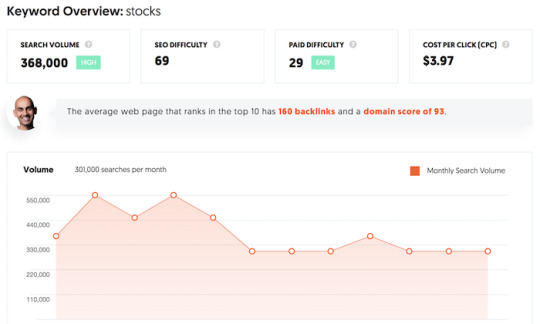
When I first got into the world of SEO, you could literally optimize your site for any term and rank at the top of Google within a month or two.
But of course, that was ages ago.
Now with Google’s ever-evolving algorithm, it takes more time and effort to get results.
But what happens if you don’t have the luxury of time? Or you don’t have the financial resources to put in the effort that is truly needed.
What should you do?
Just forget about SEO?
Of course not. Today, I want to call out 11 tools that will help you get an edge over your competition. But unlike most lists, I am going to get very specific on the feature I want you to use within each tool to make your life easier and help you get results faster with less effort.
Let’s dive right in.
Tool #1: Ubersuggest Projects
You probably already know about Ubersuggest, but do you really have time to spend hours and hours each week to do your SEO?
Chances are you don’t.
So how do you improve your traffic with the least amount of effort?
You set up a project in Ubersuggest.
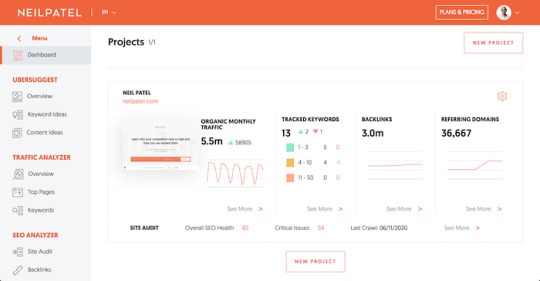
As you can see, it shows your SEO traffic over time. It will let you know if your rankings are going up or down, your link growth, and your SEO issues.

With so many things going on in marketing, you don’t have time to manually check your rankings or if things are going up or down or even what you need to fix.
Ubersuggest will do it for you all automatically and even notify you of what needs to happen through email. That way you don’t have to constantly check your SEO. Ubersuggest will do it all automatically.
More so, you’ll get notified of what you need to focus on each week to maximize your traffic.
All you have do is head to the dashboard and click on “Add Your First Project.”
It’s as simple as adding in your URL.

Then select the locations you do business in and want traffic from.
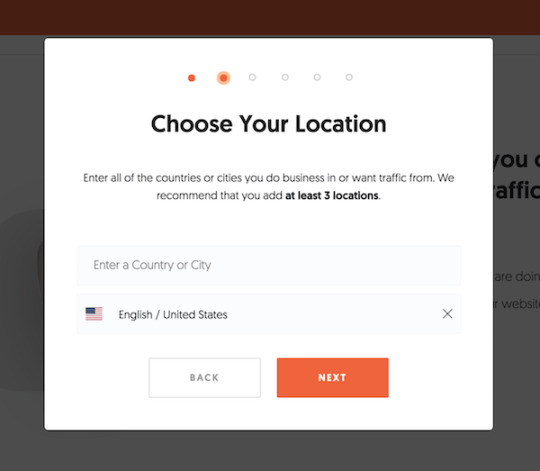
Then add in the keywords you currently rank for or want to go after.
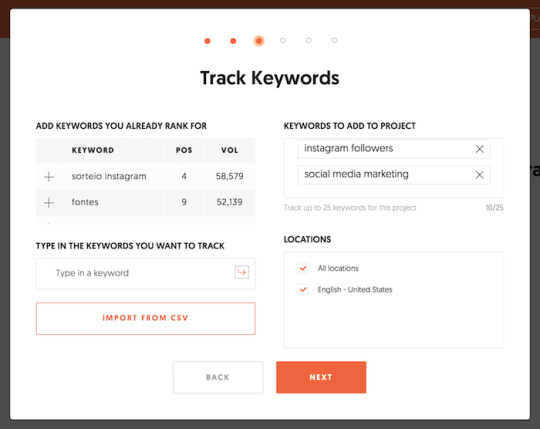
And of course, set up your traffic preferences.

And then you’ll be good to go.
Then when things go great, you’ll be notified. And when things are going wrong, you’ll also be notified. Ubersuggest will even tell you what to fix.
That way you get the maximum results in the least amount of time.
Tool #2: Google Analytics Alerts
You have Google Analytics set up on your site, but how often do you log in?
And when you do log in, do you know what to focus on or what to look at?
And if you do, do you know what to do with that data?
Google Analytics is a great tool, but you don’t want to waste hours and hours looking at reports. Instead, you want to spend your time doing and getting results.
But if you set up alerts in Google Analytics, you can save tons of time.
youtube
If you watch from the 6:33 mark, it will show you how to set up alerts. I added the whole video as it will teach you how to set up Google Analytics in general in case you don’t have goal tracking set it place.
Once you set up alerts, you’ll again get notified when anything good or bad happens. I usually have alerts set up for only when things go bad, so I know when I need to focus on fixing my marketing.
Tool #3: Trello
You’re probably thinking how the heck is Trello a marketing tool. It really isn’t, but it is a good project management tool.
And with your SEO, you may have a team helping you out and Trello will help streamline the process, make you more efficient, and get your results faster.
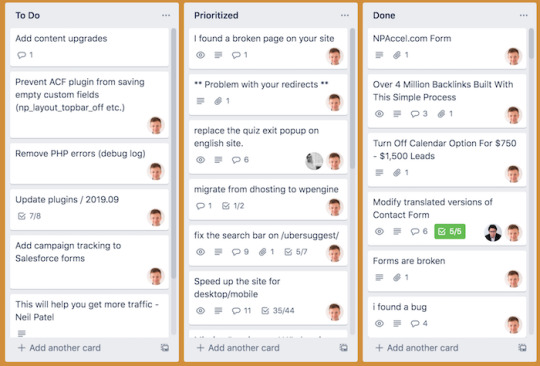
I keep my Trello board simple by breaking it into 3 sections.
To do – what needs to be done over time.
Prioritized – what I need to be done now (tasks at the top are the most important)
Done – tasks that need to be double-checked to ensure they were done right.
It’s that simple. That way you don’t have to micromanage your team.
Some people have more complex Trello boards, but something simple like I have worked too.
If you want to create a Trello board for your content marketing, assuming you want to write lots of content (such as 10 posts a week), this process works well.

The columns I use for content writers are:
Topics – this is where writers add topics they want to write about.
Outline review – writers submit their outline before they write for approval.
Draft – writers submit their rough draft.
Draft review – editors review each draft.
Uploaded, prepared, and ready to review – this is where the editor adds the post to your CMS (like WordPress).
Scheduled – this is where you schedule the content to go live.
Done – the content is now live.
We’ve found it effective if you are managing dozens of writers at once.
Tool #4: Content Decay Tool
Can you guess how many articles I write each week?
1.
Seriously, that’s it. 1 article a week which is roughly 4 to 5 per month (depending on how many weeks in the month).
And can you guess how many articles my team and I update each week?
21.
That’s roughly 90 a month.
Just think about it… why would I have a team of 3 people updating 90 articles per month when I only write 1 a week.
It’s because updating old content is an easier way to get more SEO traffic than it is to create new content.
But what content should you update?
The content decay tool will tell you that.
youtube
It breaks down in order which articles you should update first, second, third… based on what will generate you the most traffic.
If you are wondering what is involved with updating content, just think of it this way:
Is there anything outdated within your post – if so, either update the outdated information and make it relevant again. If you can’t, then delete that part from your article.
Can you use media to improve the experience – do you need to embed videos, add more pictures, maybe even add an infographic? Use media to better tell your story and message.
Are you including the right keywords – a simple way to get more traffic is to integrate other popular related keywords within your article. Whatever your article is about, insert it into Ubersuggest and head to the “Keyword Ideas” report in the left-hand navigation.
Is there anything missing – try to poke holes within your content. What could you have done to make it better? What do your competitors talk about that you forgot to mention? What questions didn’t you answer that the reader might have? By asking yourself these simple questions, you’ll be able to make it better.
Tool #5: Ubersuggest Chrome Extension
If you haven’t installed the Ubersuggest Chrome extension, make sure you do so.
I’m not going to bore you with all of the features of the extension… instead, I am going to give you one thing that will save you time.
You know when you Google for information to learn more on any subject?
Chances are, sometimes you are Googling to learn something related to your space. And when you do, you’ll find that your site usually won’t be at the top of those search results.
And that’s ok.
But when you do a search, you’ll notice “monthly searches” in the Google search bar.

This shows you how often that keyword is searched.
So anytime you are looking up anything in your space, pay attention to that number. If you see a keyword with over 5,000 searches, it may be worth targeting.
And as you scroll down and start going through the sites that rank at the top, you’ll notice metrics under each site.
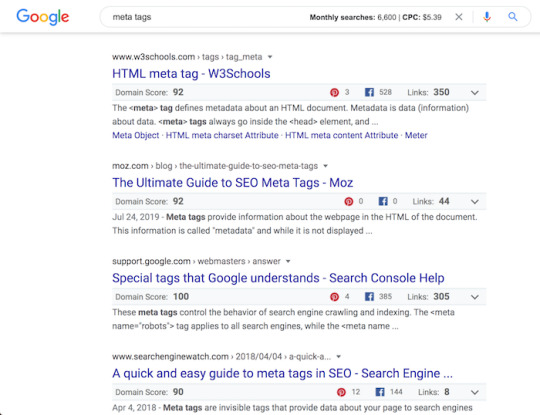
If you notice a web page with thousands of social shares and hundreds of links, it should reaffirm that you probably want to go after that term. And the listing that has thousands of social shares and hundreds of links is a good benchmark of a page that is high in quality and what people in your space prefer.
Ideally, you want to create something better than that one, as that is the main way you beat them over time.
Tool #6: Hello Bar
SEO is very different than paid traffic.
With paid traffic, you can drive people to a landing page with very little content, which makes it easier to generate sales or leads.
With SEO, Google prefers to rank content-rich sites.
But when someone lands on a page full of educational-based content, they are less likely to convert into a customer.
There’s a simple fix… Hello Bar.
Hello Bar has a lot of features, but I just want you to use the top bar like I do on NeilPatel.com.
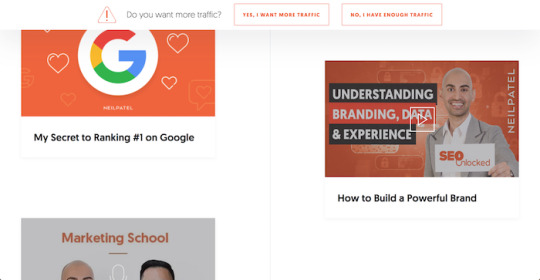
And as you scroll it moves along with you.
That one little thing allows me to improve my conversion rate from my SEO traffic.
You can easily adjust what you show with a few simple clicks within Hello Bar or you can even show people different messages based on where they are coming from.

Although SEO traffic doesn’t convert as well as paid traffic, it is much cheaper in the long run and does have a better overall ROI. And that one little Hello Bar will improve your numbers.
It’s responsible for 9.4% of revenue from NeilPatel.com.
Every little bit adds up.
Tool #7: Mozcast
Google makes over 3,200 algorithm changes a year.
Are you really going to keep up to date with all of them?
If you followed the first tool and set up a project in Ubersuggest, you’ll get notified when your rankings go down.
And if you set up alerts in Google Analytics (tool number 2) you’ll also get notified when your traffic drops drastically.
What you’ll find is that it’s overwhelming to keep up with all of Google’s updates and it could be confusing to figure out what you need to fix to get your traffic back.
This report on Moz keeps track of all of the algorithm updates and gives you an overview of what has changed or what the update is about. On top of that, you’ll want to check out the Mozcast if you get a notification of ranking or traffic drops as this tool confirms if other people are also seeing changes from a Google update.
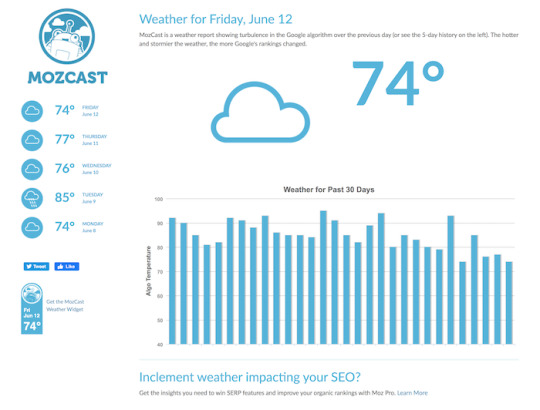
Keep in mind that Google doesn’t announce each update, hence you’ll want to cross-reference what you are seeing with the Mozcast.
That way you don’t have to spend hours researching each update.
Tool #8: Detailed
Link building is a pain. There are so many link tools like this one… but let’s not kid ourselves… you just don’t have the time to spend 10 to 20 hours a week doing link building.
So, each minute you spend, you have to make sure it counts.
There’s a tool called Detailed that breaks down the best links for every industry.
All you have to do is select an industry and a site and it shows you all of the good links that are going to your competition.

You can then focus your efforts on reaching out to those sites to get links.
Sure, you will still need to have amazing content or a good product or service in order to convince those sites to link to you, but hey, if you don’t have any of that it’s going to be hard to do well in the first place.
So, don’t waste your time trying to search for links when Detailed will give you a list of hundreds of amazing sites to get links from within your space.
Tool #9: Site Speed Audit
Speed impacts rankings.
Google doesn’t want to rank slow websites anymore.
It doesn’t matter that technology has become better and you can now purchase satellite Internet. Not every location has blazing fast Internet.
For that reason, Google has an Accelerated Mobile Pages framework that helps with mobile load time.
But that’s not enough, you also need your website to load fast.
So, go here and put in your URL.
You’ll then be taken to a report that looks like this:
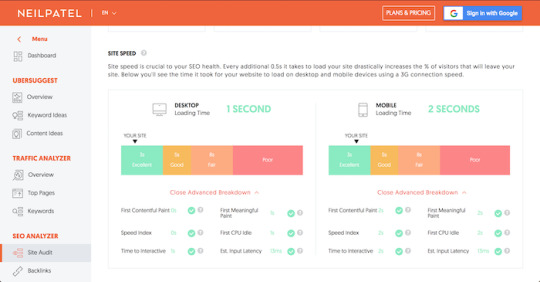
What’ll you want to focus on is site speed. That Ubersuggest report pulls from Google Lighthouse.
So, send that to your developer and tell them to get you in the green mark for both mobile and desktop load times.
As your speed goes up, so will your SEO rankings and traffic over time.
Tool #10: Supermetrics
Are you tired of having your data everywhere?
Why would you want to log into four of five different apps to get your SEO and marketing data when you could log into one.
And no, I am not talking about Google Analytics. I am talking about Google Data Studio.
If you haven’t used it yet, sign up for it… it’s free.

Google Data Studio is a business intelligence tool that will show you all of your data in one place.
So how do you get all of your SEO data into Google Data Studio? You use Supermetrics.
It passes all of your SEO data from different sources into Data Studio, so you no longer have to log into multiple tools, including Google Analytics.
My favorite feature in Supermetrics is you can automate your marketing reporting, so you no longer have to create your reports manually.
Tool #11: VidIQ
Google is the most popular search engine.
But do you know what the second most popular search engine is?
It’s not Bing… it’s actually YouTube, which Google actually owns.
If you haven’t done YouTube SEO yet, you should reconsider. Just look at how much search traffic I get from YouTube each month.

This article will break down how to do YouTube SEO if you want to learn how it works.
But to make things easier, install this Chrome extension.
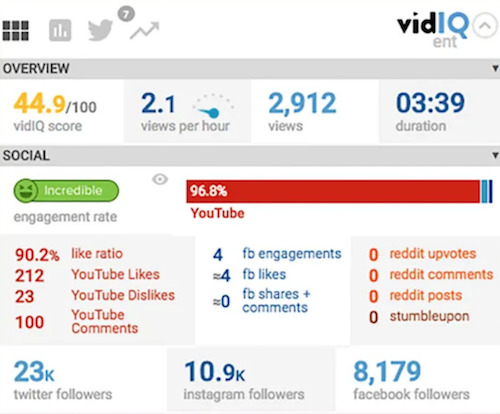
Whenever you perform a search on YouTube it will show you what’s popular, what keywords are being searched that are related to each video, and which tags people are using to get more SEO traffic.
I wanted to end this post with VidIQ because it’s not competitive.
See, unlike traditional SEO, it doesn’t take months to see results. YouTube SEO is the opposite in which it isn’t as competitive (yet) and you can rank at the top within 24 to 48 hours of releasing a video (seriously!).
Conclusion
They say SEO is hard and time-consuming. And I am not going to lie, you won’t get results unless you put in some effort.
But who says it has to be as time-consuming?
By using some of the tools I mentioned above you’ll save time. It really is that simple.
I know there is a lot and it can be overwhelming. So if you don’t have time to use all of the tools it is fine… just start at the top and work your way down (I put them in order based on what will save you the most time).
What other ways do you save time on your SEO?
The post The SEO Tool Kit: 11 Tools That’ll Save You Time appeared first on Neil Patel.
Original content source: https://neilpatel.com/blog/seo-tool-kit/ via https://neilpatel.com
The original post, The SEO Tool Kit: 11 Tools That’ll Save You Time, has been shared from https://imtrainingparadise.wordpress.com/2020/06/16/the-seo-tool-kit-11-tools-thatll-save-you-time/ via https://imtrainingparadise.wordpress.com
0 notes
Text
The SEO Tool Kit: 11 Tools That’ll Save You Time

When I first got into the world of SEO, you could literally optimize your site for any term and rank at the top of Google within a month or two.
But of course, that was ages ago.
Now with Google’s ever-evolving algorithm, it takes more time and effort to get results.
But what happens if you don’t have the luxury of time? Or you don’t have the financial resources to put in the effort that is truly needed.
What should you do?
Just forget about SEO?
Of course not. Today, I want to call out 11 tools that will help you get an edge over your competition. But unlike most lists, I am going to get very specific on the feature I want you to use within each tool to make your life easier and help you get results faster with less effort.
Let’s dive right in.
Tool #1: Ubersuggest Projects
You probably already know about Ubersuggest, but do you really have time to spend hours and hours each week to do your SEO?
Chances are you don’t.
So how do you improve your traffic with the least amount of effort?
You set up a project in Ubersuggest.

As you can see, it shows your SEO traffic over time. It will let you know if your rankings are going up or down, your link growth, and your SEO issues.

With so many things going on in marketing, you don’t have time to manually check your rankings or if things are going up or down or even what you need to fix.
Ubersuggest will do it for you all automatically and even notify you of what needs to happen through email. That way you don’t have to constantly check your SEO. Ubersuggest will do it all automatically.
More so, you’ll get notified of what you need to focus on each week to maximize your traffic.
All you have do is head to the dashboard and click on “Add Your First Project.”
It’s as simple as adding in your URL.
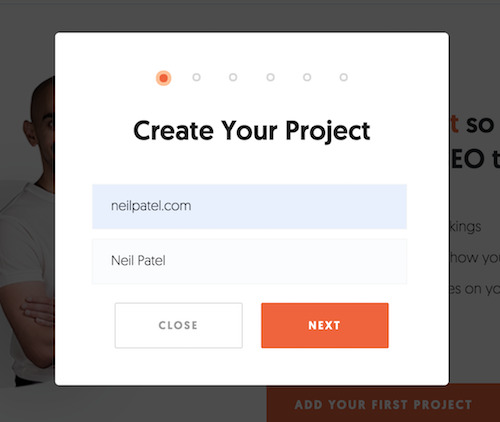
Then select the locations you do business in and want traffic from.
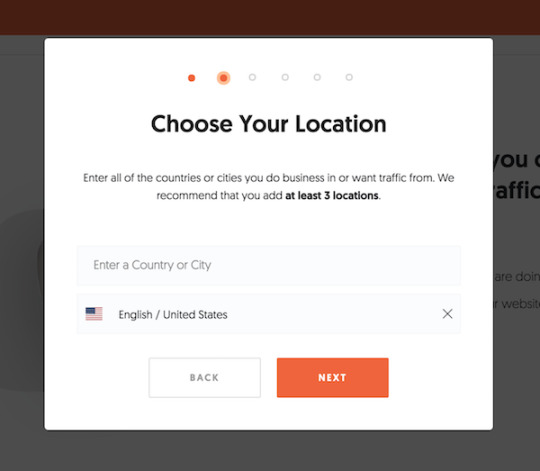
Then add in the keywords you currently rank for or want to go after.

And of course, set up your traffic preferences.
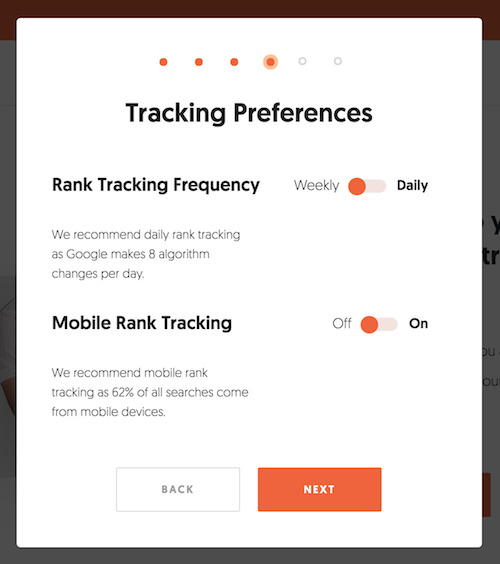
And then you’ll be good to go.
Then when things go great, you’ll be notified. And when things are going wrong, you’ll also be notified. Ubersuggest will even tell you what to fix.
That way you get the maximum results in the least amount of time.
Tool #2: Google Analytics Alerts
You have Google Analytics set up on your site, but how often do you log in?
And when you do log in, do you know what to focus on or what to look at?
And if you do, do you know what to do with that data?
Google Analytics is a great tool, but you don’t want to waste hours and hours looking at reports. Instead, you want to spend your time doing and getting results.
But if you set up alerts in Google Analytics, you can save tons of time.
youtube
If you watch from the 6:33 mark, it will show you how to set up alerts. I added the whole video as it will teach you how to set up Google Analytics in general in case you don’t have goal tracking set it place.
Once you set up alerts, you’ll again get notified when anything good or bad happens. I usually have alerts set up for only when things go bad, so I know when I need to focus on fixing my marketing.
Tool #3: Trello
You’re probably thinking how the heck is Trello a marketing tool. It really isn’t, but it is a good project management tool.
And with your SEO, you may have a team helping you out and Trello will help streamline the process, make you more efficient, and get your results faster.

I keep my Trello board simple by breaking it into 3 sections.
To do – what needs to be done over time.
Prioritized – what I need to be done now (tasks at the top are the most important)
Done – tasks that need to be double-checked to ensure they were done right.
It’s that simple. That way you don’t have to micromanage your team.
Some people have more complex Trello boards, but something simple like I have worked too.
If you want to create a Trello board for your content marketing, assuming you want to write lots of content (such as 10 posts a week), this process works well.

The columns I use for content writers are:
Topics – this is where writers add topics they want to write about.
Outline review – writers submit their outline before they write for approval.
Draft – writers submit their rough draft.
Draft review – editors review each draft.
Uploaded, prepared, and ready to review – this is where the editor adds the post to your CMS (like WordPress).
Scheduled – this is where you schedule the content to go live.
Done – the content is now live.
We’ve found it effective if you are managing dozens of writers at once.
Tool #4: Content Decay Tool
Can you guess how many articles I write each week?
1.
Seriously, that’s it. 1 article a week which is roughly 4 to 5 per month (depending on how many weeks in the month).
And can you guess how many articles my team and I update each week?
21.
That’s roughly 90 a month.
Just think about it… why would I have a team of 3 people updating 90 articles per month when I only write 1 a week.
It’s because updating old content is an easier way to get more SEO traffic than it is to create new content.
But what content should you update?
The content decay tool will tell you that.
youtube
It breaks down in order which articles you should update first, second, third… based on what will generate you the most traffic.
If you are wondering what is involved with updating content, just think of it this way:
Is there anything outdated within your post – if so, either update the outdated information and make it relevant again. If you can’t, then delete that part from your article.
Can you use media to improve the experience – do you need to embed videos, add more pictures, maybe even add an infographic? Use media to better tell your story and message.
Are you including the right keywords – a simple way to get more traffic is to integrate other popular related keywords within your article. Whatever your article is about, insert it into Ubersuggest and head to the “Keyword Ideas” report in the left-hand navigation.
Is there anything missing – try to poke holes within your content. What could you have done to make it better? What do your competitors talk about that you forgot to mention? What questions didn’t you answer that the reader might have? By asking yourself these simple questions, you’ll be able to make it better.
Tool #5: Ubersuggest Chrome Extension
If you haven’t installed the Ubersuggest Chrome extension, make sure you do so.
I’m not going to bore you with all of the features of the extension… instead, I am going to give you one thing that will save you time.
You know when you Google for information to learn more on any subject?
Chances are, sometimes you are Googling to learn something related to your space. And when you do, you’ll find that your site usually won’t be at the top of those search results.
And that’s ok.
But when you do a search, you’ll notice “monthly searches” in the Google search bar.

This shows you how often that keyword is searched.
So anytime you are looking up anything in your space, pay attention to that number. If you see a keyword with over 5,000 searches, it may be worth targeting.
And as you scroll down and start going through the sites that rank at the top, you’ll notice metrics under each site.

If you notice a web page with thousands of social shares and hundreds of links, it should reaffirm that you probably want to go after that term. And the listing that has thousands of social shares and hundreds of links is a good benchmark of a page that is high in quality and what people in your space prefer.
Ideally, you want to create something better than that one, as that is the main way you beat them over time.
Tool #6: Hello Bar
SEO is very different than paid traffic.
With paid traffic, you can drive people to a landing page with very little content, which makes it easier to generate sales or leads.
With SEO, Google prefers to rank content-rich sites.
But when someone lands on a page full of educational-based content, they are less likely to convert into a customer.
There’s a simple fix… Hello Bar.
Hello Bar has a lot of features, but I just want you to use the top bar like I do on NeilPatel.com.
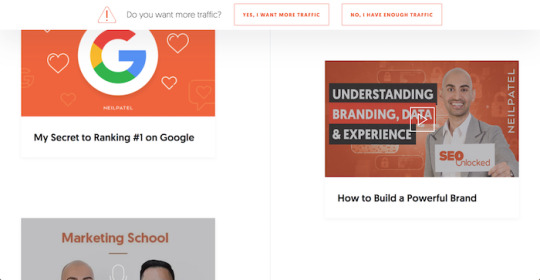
And as you scroll it moves along with you.
That one little thing allows me to improve my conversion rate from my SEO traffic.
You can easily adjust what you show with a few simple clicks within Hello Bar or you can even show people different messages based on where they are coming from.

Although SEO traffic doesn’t convert as well as paid traffic, it is much cheaper in the long run and does have a better overall ROI. And that one little Hello Bar will improve your numbers.
It’s responsible for 9.4% of revenue from NeilPatel.com.
Every little bit adds up.
Tool #7: Mozcast
Google makes over 3,200 algorithm changes a year.
Are you really going to keep up to date with all of them?
If you followed the first tool and set up a project in Ubersuggest, you’ll get notified when your rankings go down.
And if you set up alerts in Google Analytics (tool number 2) you’ll also get notified when your traffic drops drastically.
What you’ll find is that it’s overwhelming to keep up with all of Google’s updates and it could be confusing to figure out what you need to fix to get your traffic back.
This report on Moz keeps track of all of the algorithm updates and gives you an overview of what has changed or what the update is about. On top of that, you’ll want to check out the Mozcast if you get a notification of ranking or traffic drops as this tool confirms if other people are also seeing changes from a Google update.

Keep in mind that Google doesn’t announce each update, hence you’ll want to cross-reference what you are seeing with the Mozcast.
That way you don’t have to spend hours researching each update.
Tool #8: Detailed
Link building is a pain. There are so many link tools like this one… but let’s not kid ourselves… you just don’t have the time to spend 10 to 20 hours a week doing link building.
So, each minute you spend, you have to make sure it counts.
There’s a tool called Detailed that breaks down the best links for every industry.
All you have to do is select an industry and a site and it shows you all of the good links that are going to your competition.
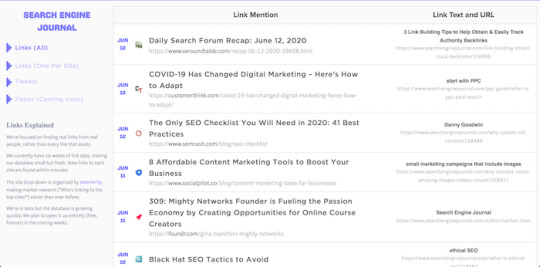
You can then focus your efforts on reaching out to those sites to get links.
Sure, you will still need to have amazing content or a good product or service in order to convince those sites to link to you, but hey, if you don’t have any of that it’s going to be hard to do well in the first place.
So, don’t waste your time trying to search for links when Detailed will give you a list of hundreds of amazing sites to get links from within your space.
Tool #9: Site Speed Audit
Speed impacts rankings.
Google doesn’t want to rank slow websites anymore.
It doesn’t matter that technology has become better and you can now purchase satellite Internet. Not every location has blazing fast Internet.
For that reason, Google has an Accelerated Mobile Pages framework that helps with mobile load time.
But that’s not enough, you also need your website to load fast.
So, go here and put in your URL.
You’ll then be taken to a report that looks like this:
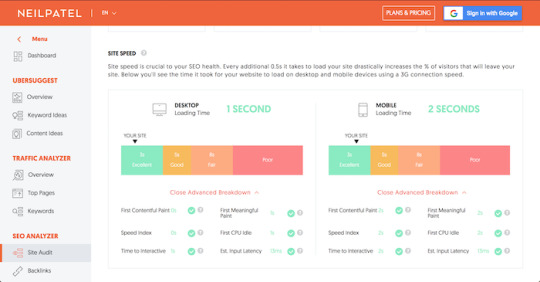
What’ll you want to focus on is site speed. That Ubersuggest report pulls from Google Lighthouse.
So, send that to your developer and tell them to get you in the green mark for both mobile and desktop load times.
As your speed goes up, so will your SEO rankings and traffic over time.
Tool #10: Supermetrics
Are you tired of having your data everywhere?
Why would you want to log into four of five different apps to get your SEO and marketing data when you could log into one.
And no, I am not talking about Google Analytics. I am talking about Google Data Studio.
If you haven’t used it yet, sign up for it… it’s free.

Google Data Studio is a business intelligence tool that will show you all of your data in one place.
So how do you get all of your SEO data into Google Data Studio? You use Supermetrics.
It passes all of your SEO data from different sources into Data Studio, so you no longer have to log into multiple tools, including Google Analytics.
My favorite feature in Supermetrics is you can automate your marketing reporting, so you no longer have to create your reports manually.
Tool #11: VidIQ
Google is the most popular search engine.
But do you know what the second most popular search engine is?
It’s not Bing… it’s actually YouTube, which Google actually owns.
If you haven’t done YouTube SEO yet, you should reconsider. Just look at how much search traffic I get from YouTube each month.
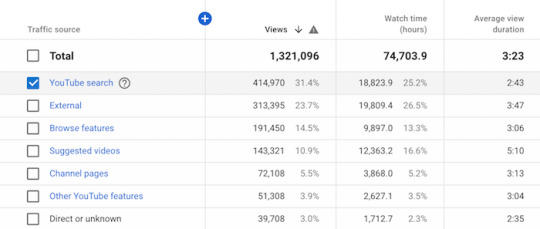
This article will break down how to do YouTube SEO if you want to learn how it works.
But to make things easier, install this Chrome extension.

Whenever you perform a search on YouTube it will show you what’s popular, what keywords are being searched that are related to each video, and which tags people are using to get more SEO traffic.
I wanted to end this post with VidIQ because it’s not competitive.
See, unlike traditional SEO, it doesn’t take months to see results. YouTube SEO is the opposite in which it isn’t as competitive (yet) and you can rank at the top within 24 to 48 hours of releasing a video (seriously!).
Conclusion
They say SEO is hard and time-consuming. And I am not going to lie, you won’t get results unless you put in some effort.
But who says it has to be as time-consuming?
By using some of the tools I mentioned above you’ll save time. It really is that simple.
I know there is a lot and it can be overwhelming. So if you don’t have time to use all of the tools it is fine… just start at the top and work your way down (I put them in order based on what will save you the most time).
What other ways do you save time on your SEO?
The post The SEO Tool Kit: 11 Tools That’ll Save You Time appeared first on Neil Patel.
The SEO Tool Kit: 11 Tools That’ll Save You Time Publicado primeiro em https://neilpatel.com
0 notes
Text
The SEO Tool Kit: 11 Tools That’ll Save You Time

When I first got into the world of SEO, you could literally optimize your site for any term and rank at the top of Google within a month or two.
But of course, that was ages ago.
Now with Google’s ever-evolving algorithm, it takes more time and effort to get results.
But what happens if you don’t have the luxury of time? Or you don’t have the financial resources to put in the effort that is truly needed.
What should you do?
Just forget about SEO?
Of course not. Today, I want to call out 11 tools that will help you get an edge over your competition. But unlike most lists, I am going to get very specific on the feature I want you to use within each tool to make your life easier and help you get results faster with less effort.
Let’s dive right in.
Tool #1: Ubersuggest Projects
You probably already know about Ubersuggest, but do you really have time to spend hours and hours each week to do your SEO?
Chances are you don’t.
So how do you improve your traffic with the least amount of effort?
You set up a project in Ubersuggest.
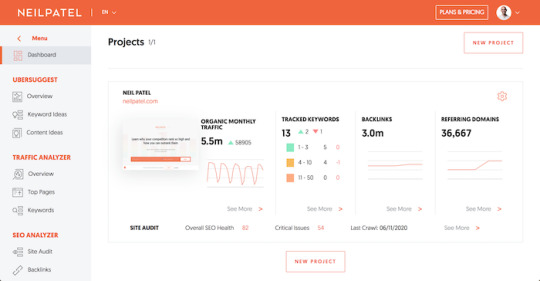
As you can see, it shows your SEO traffic over time. It will let you know if your rankings are going up or down, your link growth, and your SEO issues.
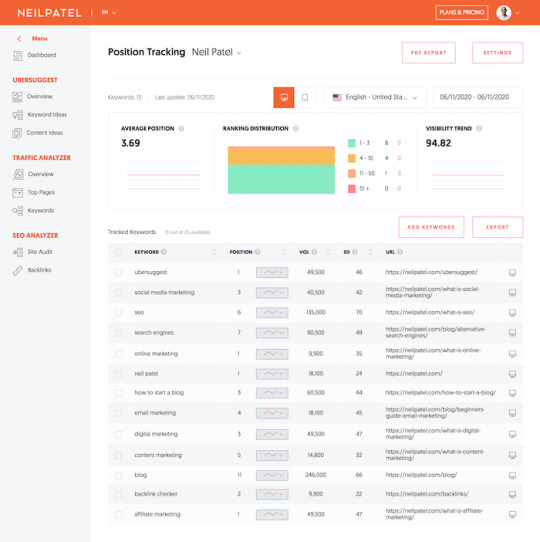
With so many things going on in marketing, you don’t have time to manually check your rankings or if things are going up or down or even what you need to fix.
Ubersuggest will do it for you all automatically and even notify you of what needs to happen through email. That way you don’t have to constantly check your SEO. Ubersuggest will do it all automatically.
More so, you’ll get notified of what you need to focus on each week to maximize your traffic.
All you have do is head to the dashboard and click on “Add Your First Project.”
It’s as simple as adding in your URL.
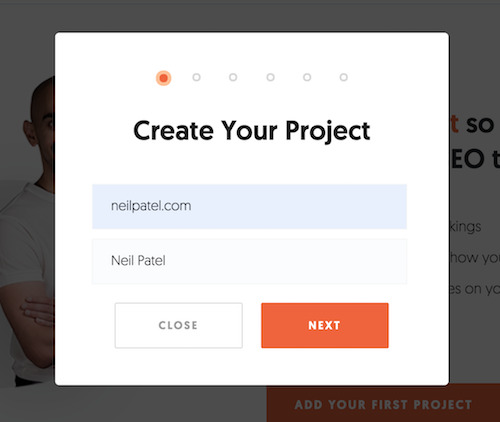
Then select the locations you do business in and want traffic from.

Then add in the keywords you currently rank for or want to go after.

And of course, set up your traffic preferences.
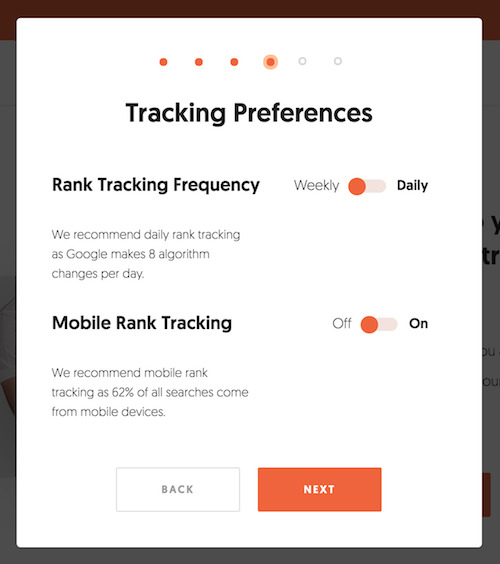
And then you’ll be good to go.
Then when things go great, you’ll be notified. And when things are going wrong, you’ll also be notified. Ubersuggest will even tell you what to fix.
That way you get the maximum results in the least amount of time.
Tool #2: Google Analytics Alerts
You have Google Analytics set up on your site, but how often do you log in?
And when you do log in, do you know what to focus on or what to look at?
And if you do, do you know what to do with that data?
Google Analytics is a great tool, but you don’t want to waste hours and hours looking at reports. Instead, you want to spend your time doing and getting results.
But if you set up alerts in Google Analytics, you can save tons of time.
youtube
If you watch from the 6:33 mark, it will show you how to set up alerts. I added the whole video as it will teach you how to set up Google Analytics in general in case you don’t have goal tracking set it place.
Once you set up alerts, you’ll again get notified when anything good or bad happens. I usually have alerts set up for only when things go bad, so I know when I need to focus on fixing my marketing.
Tool #3: Trello
You’re probably thinking how the heck is Trello a marketing tool. It really isn’t, but it is a good project management tool.
And with your SEO, you may have a team helping you out and Trello will help streamline the process, make you more efficient, and get your results faster.
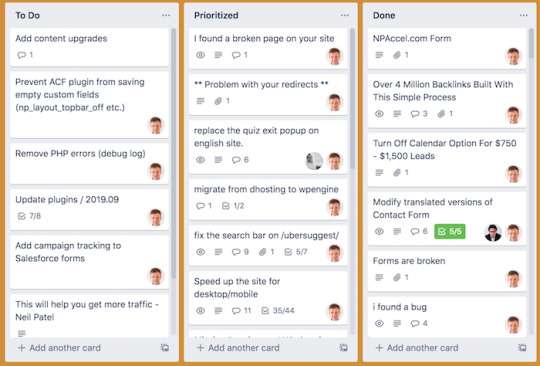
I keep my Trello board simple by breaking it into 3 sections.
To do – what needs to be done over time.
Prioritized – what I need to be done now (tasks at the top are the most important)
Done – tasks that need to be double-checked to ensure they were done right.
It’s that simple. That way you don’t have to micromanage your team.
Some people have more complex Trello boards, but something simple like I have worked too.
If you want to create a Trello board for your content marketing, assuming you want to write lots of content (such as 10 posts a week), this process works well.

The columns I use for content writers are:
Topics – this is where writers add topics they want to write about.
Outline review – writers submit their outline before they write for approval.
Draft – writers submit their rough draft.
Draft review – editors review each draft.
Uploaded, prepared, and ready to review – this is where the editor adds the post to your CMS (like WordPress).
Scheduled – this is where you schedule the content to go live.
Done – the content is now live.
We’ve found it effective if you are managing dozens of writers at once.
Tool #4: Content Decay Tool
Can you guess how many articles I write each week?
1.
Seriously, that’s it. 1 article a week which is roughly 4 to 5 per month (depending on how many weeks in the month).
And can you guess how many articles my team and I update each week?
21.
That’s roughly 90 a month.
Just think about it… why would I have a team of 3 people updating 90 articles per month when I only write 1 a week.
It’s because updating old content is an easier way to get more SEO traffic than it is to create new content.
But what content should you update?
The content decay tool will tell you that.
youtube
It breaks down in order which articles you should update first, second, third… based on what will generate you the most traffic.
If you are wondering what is involved with updating content, just think of it this way:
Is there anything outdated within your post – if so, either update the outdated information and make it relevant again. If you can’t, then delete that part from your article.
Can you use media to improve the experience – do you need to embed videos, add more pictures, maybe even add an infographic? Use media to better tell your story and message.
Are you including the right keywords – a simple way to get more traffic is to integrate other popular related keywords within your article. Whatever your article is about, insert it into Ubersuggest and head to the “Keyword Ideas” report in the left-hand navigation.
Is there anything missing – try to poke holes within your content. What could you have done to make it better? What do your competitors talk about that you forgot to mention? What questions didn’t you answer that the reader might have? By asking yourself these simple questions, you’ll be able to make it better.
Tool #5: Ubersuggest Chrome Extension
If you haven’t installed the Ubersuggest Chrome extension, make sure you do so.
I’m not going to bore you with all of the features of the extension… instead, I am going to give you one thing that will save you time.
You know when you Google for information to learn more on any subject?
Chances are, sometimes you are Googling to learn something related to your space. And when you do, you’ll find that your site usually won’t be at the top of those search results.
And that’s ok.
But when you do a search, you’ll notice “monthly searches” in the Google search bar.

This shows you how often that keyword is searched.
So anytime you are looking up anything in your space, pay attention to that number. If you see a keyword with over 5,000 searches, it may be worth targeting.
And as you scroll down and start going through the sites that rank at the top, you’ll notice metrics under each site.

If you notice a web page with thousands of social shares and hundreds of links, it should reaffirm that you probably want to go after that term. And the listing that has thousands of social shares and hundreds of links is a good benchmark of a page that is high in quality and what people in your space prefer.
Ideally, you want to create something better than that one, as that is the main way you beat them over time.
Tool #6: Hello Bar
SEO is very different than paid traffic.
With paid traffic, you can drive people to a landing page with very little content, which makes it easier to generate sales or leads.
With SEO, Google prefers to rank content-rich sites.
But when someone lands on a page full of educational-based content, they are less likely to convert into a customer.
There’s a simple fix… Hello Bar.
Hello Bar has a lot of features, but I just want you to use the top bar like I do on NeilPatel.com.
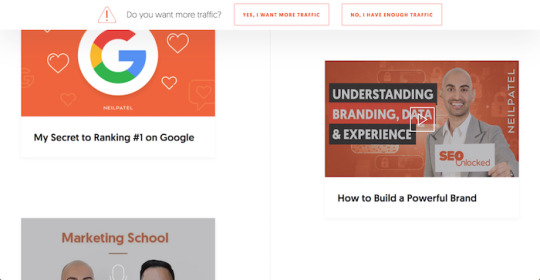
And as you scroll it moves along with you.
That one little thing allows me to improve my conversion rate from my SEO traffic.
You can easily adjust what you show with a few simple clicks within Hello Bar or you can even show people different messages based on where they are coming from.
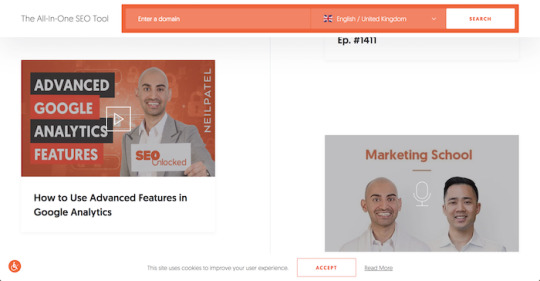
Although SEO traffic doesn’t convert as well as paid traffic, it is much cheaper in the long run and does have a better overall ROI. And that one little Hello Bar will improve your numbers.
It’s responsible for 9.4% of revenue from NeilPatel.com.
Every little bit adds up.
Tool #7: Mozcast
Google makes over 3,200 algorithm changes a year.
Are you really going to keep up to date with all of them?
If you followed the first tool and set up a project in Ubersuggest, you’ll get notified when your rankings go down.
And if you set up alerts in Google Analytics (tool number 2) you’ll also get notified when your traffic drops drastically.
What you’ll find is that it’s overwhelming to keep up with all of Google’s updates and it could be confusing to figure out what you need to fix to get your traffic back.
This report on Moz keeps track of all of the algorithm updates and gives you an overview of what has changed or what the update is about. On top of that, you’ll want to check out the Mozcast if you get a notification of ranking or traffic drops as this tool confirms if other people are also seeing changes from a Google update.
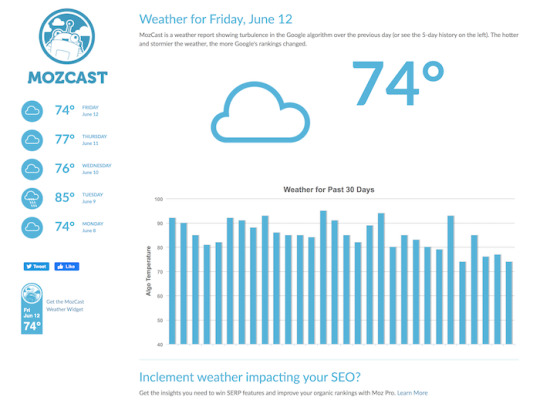
Keep in mind that Google doesn’t announce each update, hence you’ll want to cross-reference what you are seeing with the Mozcast.
That way you don’t have to spend hours researching each update.
Tool #8: Detailed
Link building is a pain. There are so many link tools like this one… but let’s not kid ourselves… you just don’t have the time to spend 10 to 20 hours a week doing link building.
So, each minute you spend, you have to make sure it counts.
There’s a tool called Detailed that breaks down the best links for every industry.
All you have to do is select an industry and a site and it shows you all of the good links that are going to your competition.
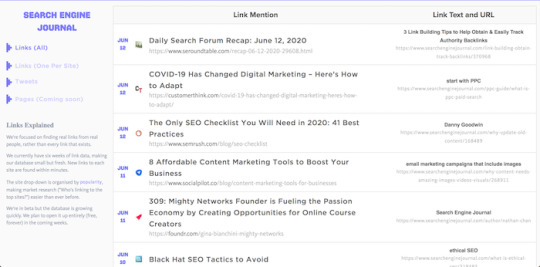
You can then focus your efforts on reaching out to those sites to get links.
Sure, you will still need to have amazing content or a good product or service in order to convince those sites to link to you, but hey, if you don’t have any of that it’s going to be hard to do well in the first place.
So, don’t waste your time trying to search for links when Detailed will give you a list of hundreds of amazing sites to get links from within your space.
Tool #9: Site Speed Audit
Speed impacts rankings.
Google doesn’t want to rank slow websites anymore.
It doesn’t matter that technology has become better and you can now purchase satellite Internet. Not every location has blazing fast Internet.
For that reason, Google has an Accelerated Mobile Pages framework that helps with mobile load time.
But that’s not enough, you also need your website to load fast.
So, go here and put in your URL.
You’ll then be taken to a report that looks like this:

What’ll you want to focus on is site speed. That Ubersuggest report pulls from Google Lighthouse.
So, send that to your developer and tell them to get you in the green mark for both mobile and desktop load times.
As your speed goes up, so will your SEO rankings and traffic over time.
Tool #10: Supermetrics
Are you tired of having your data everywhere?
Why would you want to log into four of five different apps to get your SEO and marketing data when you could log into one.
And no, I am not talking about Google Analytics. I am talking about Google Data Studio.
If you haven’t used it yet, sign up for it… it’s free.
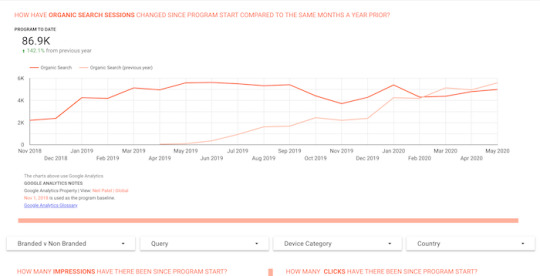
Google Data Studio is a business intelligence tool that will show you all of your data in one place.
So how do you get all of your SEO data into Google Data Studio? You use Supermetrics.
It passes all of your SEO data from different sources into Data Studio, so you no longer have to log into multiple tools, including Google Analytics.
My favorite feature in Supermetrics is you can automate your marketing reporting, so you no longer have to create your reports manually.
Tool #11: VidIQ
Google is the most popular search engine.
But do you know what the second most popular search engine is?
It’s not Bing… it’s actually YouTube, which Google actually owns.
If you haven’t done YouTube SEO yet, you should reconsider. Just look at how much search traffic I get from YouTube each month.

This article will break down how to do YouTube SEO if you want to learn how it works.
But to make things easier, install this Chrome extension.

Whenever you perform a search on YouTube it will show you what’s popular, what keywords are being searched that are related to each video, and which tags people are using to get more SEO traffic.
I wanted to end this post with VidIQ because it’s not competitive.
See, unlike traditional SEO, it doesn’t take months to see results. YouTube SEO is the opposite in which it isn’t as competitive (yet) and you can rank at the top within 24 to 48 hours of releasing a video (seriously!).
Conclusion
They say SEO is hard and time-consuming. And I am not going to lie, you won’t get results unless you put in some effort.
But who says it has to be as time-consuming?
By using some of the tools I mentioned above you’ll save time. It really is that simple.
I know there is a lot and it can be overwhelming. So if you don’t have time to use all of the tools it is fine… just start at the top and work your way down (I put them in order based on what will save you the most time).
What other ways do you save time on your SEO?
The post The SEO Tool Kit: 11 Tools That’ll Save You Time appeared first on Neil Patel.
Original content source: https://ift.tt/2YAJL0G via https://neilpatel.com The post, The SEO Tool Kit: 11 Tools That’ll Save You Time, has been shared from https://ift.tt/2ULC7zh via https://ift.tt/2r0Go64
0 notes
Text
New Post has been published on Website Design Naples Florida Webmaster
New Post has been published on https://vinbo.com/my-15-all-time-best-seo-tips-that-get-results/
My 15 All-Time BEST SEO Tips (That Get Results)

All the tips I'm going to share with you are insanely actionable, I'm brian dean, the founder of backlinko, and in this article i'm going to reveal my favorite keyword, research strategy. What I learned from analyzing, 1 million google search results and a new SEO technique.

That's crushing it right now stay tuned before I reveal tip number one. A quick word of warning: the tips I'm about to share with you aren't the here today gone tomorrow: strategies that stopped working after a few months. In fact, I've used some of these techniques since way back in 2012 and they still work great. Why? Because my SEO tips give Google what it wants so, whether you're reading this today or three years from now, you can use the techniques from this article to get higher rankings and more traffic.
So without further ado, let's dive right in with tip number one, which is to use short URLs. When I first started with SEO, I'd use the first URL that popped into my head and that led to long ugly, URLs like this today. I make sure to only use short URLs. Why? Because all things being equal short URLs rank better than long URLs. In fact, I recently analyzed 1 million google search results and we discovered that short URLs ranked best in Google.
Let's move on to tip number 2, which is to use Amazon for keyword ideas. Did you know that you can use Amazon for keyword research? Well, you can here's how first find a popular book in your niche on Amazon next check out the books table of contents? Each chapter is a potential topic or keyword idea. Finally, pop the chapter titles into your favorite keyword, research tool to see if they get searched for in Google.
Now it's time for a third tip, which is to optimize your title tag for CTR. I probably don't need to tell you that you should include your target keyword in your title tag, but what you might not know is that you also want to optimize your title tag for click-through rate. Why two reasons? First, when you improve your CTR, you get more traffic without needing higher rankings. For example, let's say that you rank number four for your target keyword.
If you double your CTR, you double your traffic. Second, Google recently stated that they use CTR as a ranking signal, and this makes sense, if you think about it, if people click on your result, it sends a clear message to Google that this page is a great result for this keyword and they'll. Give you a ranking, boost bottom line optimize your title tag not just for keywords, but for CTR too I'll.
Show you exactly how to boost your click-through rate later in this article, but for now, let's dive in to tip number four, which is to publish content. That's at least one thousand eight hundred and ninety words remember that ranking factor study that I mentioned earlier well. One of the most interesting findings was that longer content tended to rank better than short content. In fact, we found that the average first page result in Google contained 1890 words.
Yes, this goes against the idea that people online have short attention spans, but the data proves this clearly isn't true, because the fact is this: when you create a high value resource, people will want to read it even if it's really long. For example, I've opposed to my blog called ecommerce SEO the definitive guide. This post is over 5,000 words and it ranks in the top three of Google for my target keyword, ecommerce SEO bottom line.
If you have a page that you really want to rank, make sure it contains at least one thousand eight hundred ninety words of awesome content, let's dive right into tip number five use title tag, modifiers believe it or not, but most of your search engine traffic comes From very long, very specific searches, for example, someone's searching for a new pair of slippers might search for something like this, as you might expect.
Insanely long keywords like this aren't going to show up in any keyword research tool if they don't show up in a tool. How can you possibly optimizer on them? It's easy, just add modifiers to your title tag. Some of my favorite title tag. Modifiers are the current year best review free shipping and checklist. So you want to make your title tags looks something like this with a title tag like this you'll rank for your target keyword, fluffy slippers and dozens of longtail keywords.
Yes, my fluffy slipper just came in the mail with that, it's time for tip number six use keyword, rich URLs. This is a simple one. Whenever you create a URL for one of your pages, make sure it contains your target keyword. For example, here's a page at backlinko optimized around the keyword SEO tools. As you can see, the URL is short, which is the tip I showed you earlier, and you can also see that the URL contains my target keyword.
It's that simple, let's jump into tip number 7, which is to use numbers in your title tag to boost CTR. Remember a few minutes ago when I said that Google uses your site's click-through rate as a ranking factor if lots of people click on your result, it sends a clear message to Google that this page is a great result for this keyword and they'll. Give you a rankings boost. The question is: how do you improve your CTR? One of the easiest ways to get more clicks on your result is to add a number to your title tag.
According to a recent industry study titles with numbers get 36 % more clicks than titles without a number. That's why I make sure to use the number in almost every single one of my titles. Moving right along here, we're already on to tip number 8 use two-step email outreach. I probably don't need to tell you that to rank in Google today, you need to build backlinks, but not just any backlinks whitehat backlinks from authority sites in your industry.
The question is: how do you do it? In my experience? Nothing beats old-fashioned, email, outreach. That said, there's a right and wrong way to do. Email outreach. You see. Most people send out hundreds of spam emails begging for links. In fact, that's what I did back in the day. It didn't work back then, and it definitely doesn't work today. Instead, I recommend two-step email outreach. Let me explain how two-step email outreach works with the real life example.

A backlinko reader named Mike Bernardo was promoting an infographic for one of his clients at first Mike would ask for a link in his initial outreach email, but it wasn't working so he decided to try a two step approach so in Mike's, first email. Instead of asking for a link right off the bat he asked, if the blogger, a journalist would like to see his infographic when they said yes, he followed up with a link pitch and the two-step approach led to 40 % more responses than straight up asking for A link speaking of link building it's time for tip number 9 broken link building broken link building is one of my favorite white hat link building strategies.
Here's how it works first, find a site that you want to get a link from next find a broken link on that site. The easiest way to find broken links is to use the excellent check. My links, Chrome extension, when you find a broken link, look for a piece of content on your site. That would make a good replacement for the dead link. If you don't have something that would make a good replacement feel free to create one finally email, the site owner to let them know about their broken link and when they get back to you pitch your link as a replacement.
That's all there is to it all right. Next up, we have SEO tip number 10, choose keywords with strong commercial intent. Here's a mistake. I see a lot of people make and it's a mistake. I made a lot back in the day. What's the mistake? Choosing keywords that have zero commercial intent, so what does commercial intent mean exactly commercial intent? Is the likelihood that someone's searching for a giving keyword will buy from you? For example, someone searching for premium.
Yoga courses has a much higher commercial intent than someone searching for free yoga articles. Wait. I have to pay for this, I'm not here. Fortunately, you can easily size up a keywords: commercial intent using the Google Keyword planner, the higher the estimated bid that higher the commercial intent bottom line. Yes, a keyword, search volume and competition are important, but before we decide on a keyword, make sure it has at least some commercial intent.
Let's move on to tip number 11, which is the controversial one delete underperforming pages a while back a webmaster trends. Analyst at Google said something very interesting: don't create low quality and no value add pages. We think that it's a waste of resources. The other thing is that you just won't get quality traffic. If you don't get quality traffic, then why are you burning resources on it? In other words, having lots of excess pages on your site is bad for SEO, and that's why I recommend deleting pages on your site that don't bring in any traffic in fact proven calm recently deleted 10,000 pages from their site, and it's one of the main reasons That their organic traffic improved by 88 % in six weeks bottom line delete low quality pages from your site, you're, not getting any traffic anyway, so you have nothing to lose by deleting them.
In fact, in my experience, deleting these pages can help your remaining pages rank better in Google. Now it's time for our first article SEO tip optimize your articles around article keywords, as you probably notice, YouTube dominates Google's first page for so many different keywords. In fact, 45 % of all Google search results contain a YouTube article, but that also means that 55 % of Google's results don't contain a article.
Why is this important? Well, if you're trying to rank your articles in Google, you need to make sure that there are already article results for that keyword. Otherwise, your article is super unlikely to ranking Google so before deciding on a keyword for your article search for that keyword in Google. If you see a YouTube article on the first page great, you just found a article keyword. But if you search for your keyword and don't see a youtube result, then you might want to choose a different keyword to optimize your article around speaking of keywords.
Let's dive into tip number 13 use reddit for keyword. Research reddit is one of my favorite places to find untapped keywords that my competition doesn't know about. Where else can you find a site where people discuss literally every topic on to the Sun? I mean reddit has an entire section of their site, dedicated to otters, otters seriously. So how can you use reddit for keyword, research? Let me walk you through an example.
Let's say that you run a site that sells paleo diet, meal replacement bars. You do a search for Paleo diet in reddit, then check out any subreddits or threads that cover that topic. When you see a topic covered again and again, you have a keyword that you should look into that keyword into your favorite keyword, research tool to see how many people search for that term in Google, rinse and repeat until you have handfuls of Awesome keywords.
Okay, it's time for our second to last tip tip 14 link out to Authority websites want to see something interesting. An SEO agency in the UK recently ran an SEO experiment. They created 10 brand new websites, all optimized around the same made-up keyword file and dosing file. In Dokic violen dosuk, how do you even pronounce that, anyway, the 10 websites were all set up exactly the same way except five of them had one major difference.
They contained outbound links to Authority, websites and sure enough. The five sites with outbound links, ranked above the sites that didn't have any bottom line, link out to Authority websites in every piece of content that you publish, okay, here's our last tip tip number 15 hack Wikipedia for keyword. Research, just like reddit Wikipedia, is a keyword. Research goldmine, here's the exact process that I use to find amazing keywords on Wikipedia step, 1 type in a topic or keyword into Wikipedia.
For example, if your site publishes content about coffee, you'd want to type coffee into Wikipedia search step. Number two is to look at all their articles on Wikipedia that the Wikipedia article links to the anchor text of these links can be great keyword or topic ideas. Finally, for step number three look at the table of contents for that article. These can also reveal amazing keyword ideas that would be hard to find otherwise did you learn some cool new stuff in this article then make sure to subscribe to my youtube blog right now.
0 notes
Text
TikTok - What's The Strategy For Christian Personal Brands?
One of my business partners walks into the office and says “Hey dude, you gotta get on TikTok, it’s the funniest thing ever! People post videos of themselves in extremely creative and entertaining ways.”
I’m curious. So I check it out.
He was right.
It’s fun. It’s addictive!
People WILL BE INFLUENCED by the content creators on it.
The question is: what’s the best strategy for us Christian entrepreneurs to develop our personal brands on TikTok so that our message can be one that is heard…even if it’s a younger demographic.
What is TikTok
We all have teenage and early-twenties friends that have mentioned TikTok, it’s the newest rage.
And it’s not just for teens. God brought this powerful branding platform for us Christian personal brands the same way He allowed for Instagam, YouTube, and Facebook to exist.
Welcome to a Christian entrepreneur’s introduction to TikTok through the perspective of leveraging TikTok for growing your God-first personal brand and influence for the Kingdom.
TikTok is a Chinese social network that puts video first. People can post short videos, edit them, add music, and post them to their TikTok followers. It’s estimated that over 500 million people use TikTok, meaning the network is larger than Twitter and Pinterest. WOW!!
TikTok (Douyin抖音) is an amazing platform to promote our Christian personal brands because if it is true that spreading our message is our calling, then short videos give us the chance to influence others with our skills, art, abilities and inspired ideas in a fast and smart consuming way.
I use TikTokmyself for 2 main reasons:
To promote my @DailyGodpreneur Personal Brand
To study this trend and adapt my B2C marketing strategies to brands that I consult and my own companies
In personal branding and marketing, things change quickly and we can’t rely on a single platform. Today we need to concentrate not only on Instagram and YouTube, but also on Tik-Tok to reach new communities online with Kingdom-minded thoughts and inspiration.
The bible says
He said to them, “Go into all the world and preach the gospel to all creation.” (mARK 16:15)
Our primary calling as Christians is to spread the word. Our SECONDARY calling is to use our business and personal brand as a means to do that.
I’ve put together a mix of strategies, tips, and advice on building a Christian personal brand on TikTok.
We focus on China, a powerful country that offers incredible possibilities for foreigners able to adapt to the social media ecosystem. For more insight about Personal Branding for Christian Entreprenerus, click here.

Who is Behind TikTok?
TikTok is for short videos mostly 15 seconds long, but with the ability to make 60 seconds long clips. While using this platform, you’re supplied with a number of songs and many filter options to customize the videos.
TikTok is owned by ByteDance. That’s the privately held company, founded in 2006, that is, according to reports, now the most highly-valued tech startup in the world. It just raised a $3bn round of funding that valued it at $75bn. So TikTok has a lot of capital behind it, which could make it more difficult for incumbents to quash it.
TikTok burst out in 2018 and became the most downloaded iPhone app, getting the nickname of “China’s Snapchat”. Chinese adore it and they use it to show their life, passion, and talents.
Its audience is extremely young and active. According to a survey, nearly 67% of TikTok’s users are under 30 and 56% of them are students. At the same time, data shows that 43% of users live in first and second-tier cities, the developed metropolitan areas.
There are so many users and they are so different, different ages, different income, different interests that almost any Christian brand could find here its target and any creator — his audience.

As far as it’s a short-video app, it is often compared with Vine (remember that!?) Vine was actually acquired by Twitter in October 2012 prior to its official launch. In 2016, however, thanks in part to growing competition from other apps including Instagram and Snapchat, it was shut down.
Vine became popular with content creators who used it to create comedy and music shorts, and it eventually grew to 200m active users. Not surprisingly, brands were eager to get in on the act as well.
6 Reasons Why You Should Use TikTok for Your Christian Personal Brand
1) Videos are easily “digested” by your fans
People love video. Our society is hectic and TikTok offers quick bits of consumption without unnecessary complications. Short videos force you to show interesting things about your talent without tricks; the storytelling must be simple and the skills easily recognizable. This makes the platform extremely natural and interesting to follow.
15-second videos are an extremely easy way to promote your inspired ideas, make people think and awaken their interest. People adore these videos because they are easy to understand and can help them to relax.
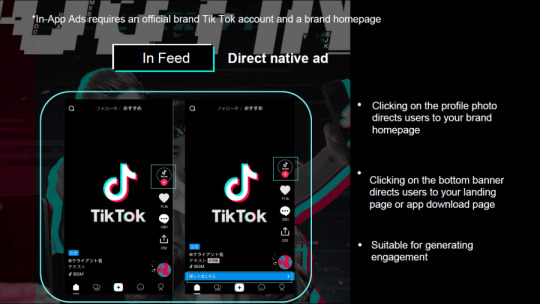
By you recording your day-to-day business life and sharing unique points of view on God via vlogs, Christian entrepreneurs can boost their personal brands and fill an unsatisfied educational, motivational or entertainment niche in their industry.

2. Your Fans are Millennials
You can just use simple in-app tools of TikTok and create original and authentic content which immediately will be delivered to a huge number of users and your customers.
Are you looking for a fresh and young audience? They’re looking for your brand here.
With the average age of a TikTok user being 13- to 24-years-old, mostly girls, TikTok is a gold mine when it comes to getting your #GodFirst message in front of Gen Z’ers.
Very creative and active, they will promote you to their friend and families, if they like you. They are looking for new things, so you can absolutely find new followers and customers here.
3. Personal Branding to Buying Your Products – Making the Switch
Ok, you’ve started and got your first audience. And what’s next? Enjoy the easy conversations with them! This audience is so affable you can receive feedback as soon as you post things.
The fastest and easiest way to engage them is by using daily challenges and a wide network of hashtags. Some of the big western brands already have created their own highly welcomed challenges.
Not so long ago fashion brand Guess launched its #InMyDenim hashtag challenge, the first-ever branded partnership with TikTok. Guess posted several “Official” videos accompanied by Bebe Rexha’s “I’m a Mess,” and then let the content creators do their work. NBC Tonight Show host Jimmy Fallon lauded the app and created the #Tumbleweed Challenge. Users posted more than 8,000 videos using this hashtag.
If you want to be involved with something buzzy, something shining brand new, operate in a different way and on a platform that has the potential for visibility in a less-crowded space. TikTok was definitely created for you.

4. Learning as a process on your Personal Branding Pilgrimage
After downloading the TikTok app you’ll find yourself in the brand new world of lifestyle and culture. Actually, it’s a good way to understand the 15-24 year-olds, what they want, what they’re looking for, what they are used to. Just spend some time scrolling through videos and soon you’ll understand how your potential audience thinks.
5. Christian Speakers: use TikTok as your Online Stage
Do you have the gift of teaching? Simply show it.

Film a few short videos about yourself, your life, your work. Let people get to know you as a speaker and exhibit your skills of influence. You can take short videos when you’re at an event, you can even have your team go LIVE with you on stage.
6. Collaborate with Other Christian Entrepreneurs
Nowadays young, highly-influenceable Christian entrepreneurs are presented with a lot of options and alternatives of similar type teachings. So we have to collaborate to present new and innovative thoughts to those that will listen.
I’ve been collaborating more with other Christian business influencers, it’s definitely on the rise within our industry. If you want to TikTok together, let me know! Since we share common goals, values, target market, and business objectives, it’s a no-brainer. Together, we could reveal the one thing our audiences never done which could transform their business life forever. Everyone wins!
Conclusion and Tips on using TikTok for Christian Personal Brands
At the moment, TikTok is a new and unfamiliar territory for us Christian business owners. Many companies are still afraid to step on unstable soil. But for Christians who want to spread their message to the world, especially the young, the return on investment might be high for the months to come! I suggest approaching the platform with a Personal Branding Strategy that leads to a clear God-First Business Branding Focus. Step by step. Don’t be boring on TikTok, be influential!
TikTok has the potential of being a major platform like Instagram and Facebook and shouldn’t be easily dismissed.
The app is still in its infancy, but the number of users joining is impressive. It’s still too early to tell the future of the app, as it may continue to rise in popularity or it could plummet.
If you are looking for your way to reach a young, new audience, an easy way to understand it and gain some interest from it TikTok is for you.
Get more Tiktok fans and strengthen your brand on this platform by checking out this infographic from Digimush.

TikTok – What’s The Strategy For Christian Personal Brands? was originally published on Daily Godpreneur with Alex Miranda
0 notes
Text
The SEO Tool Kit: 11 Tools Thatll Save You Time

When I first got into the world of SEO, you could literally optimize your site for any term and rank at the top of Google within a month or two.
But of course, that was ages ago.
Now with Google’s ever-evolving algorithm, it takes more time and effort to get results.
But what happens if you don’t have the luxury of time? Or you don’t have the financial resources to put in the effort that is truly needed.
What should you do?
Just forget about SEO?
Of course not. Today, I want to call out 11 tools that will help you get an edge over your competition. But unlike most lists, I am going to get very specific on the feature I want you to use within each tool to make your life easier and help you get results faster with less effort.
Let’s dive right in.
Tool #1: Ubersuggest Projects
You probably already know about Ubersuggest, but do you really have time to spend hours and hours each week to do your SEO?
Chances are you don’t.
So how do you improve your traffic with the least amount of effort?
You set up a project in Ubersuggest.
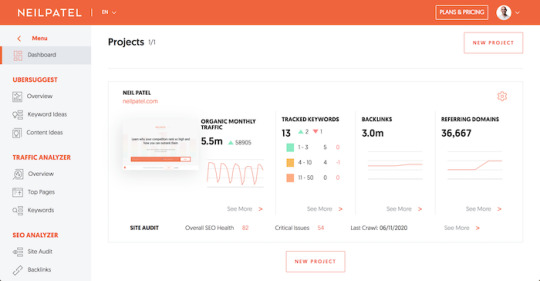
As you can see, it shows your SEO traffic over time. It will let you know if your rankings are going up or down, your link growth, and your SEO issues.
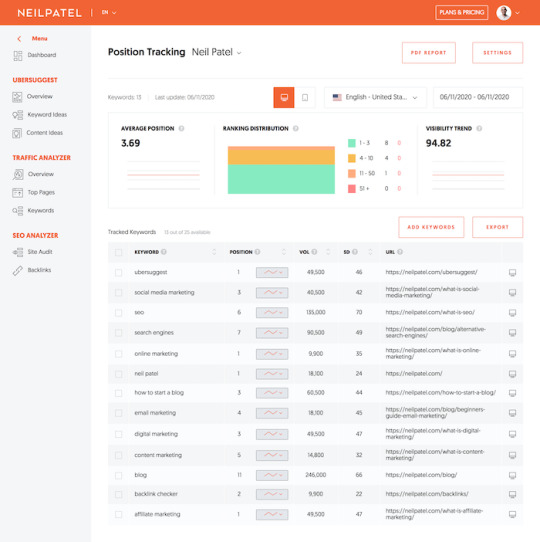
With so many things going on in marketing, you don’t have time to manually check your rankings or if things are going up or down or even what you need to fix.
Ubersuggest will do it for you all automatically and even notify you of what needs to happen through email. That way you don’t have to constantly check your SEO. Ubersuggest will do it all automatically.
More so, you’ll get notified of what you need to focus on each week to maximize your traffic.
All you have do is head to the dashboard and click on “Add Your First Project.”
It’s as simple as adding in your URL.

Then select the locations you do business in and want traffic from.
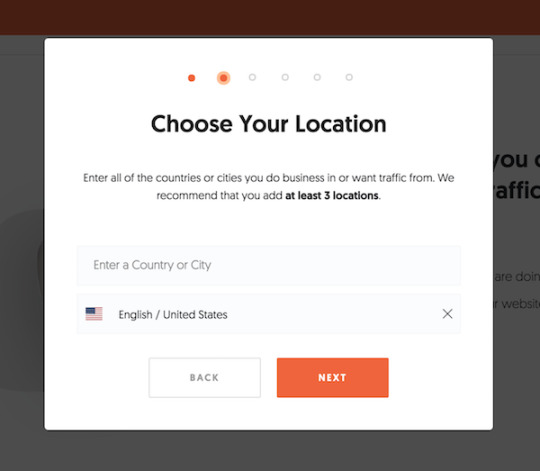
Then add in the keywords you currently rank for or want to go after.

And of course, set up your traffic preferences.
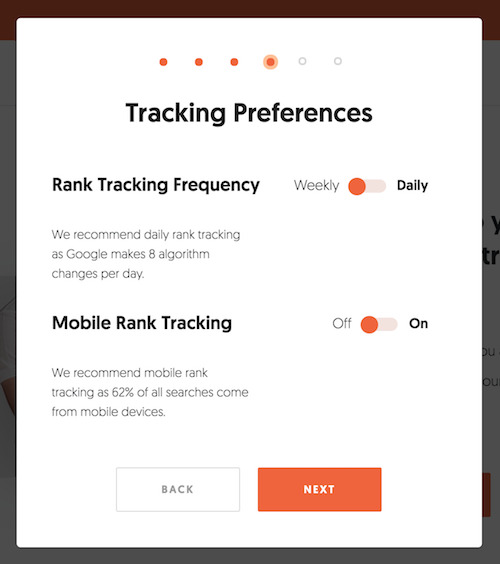
And then you’ll be good to go.
Then when things go great, you’ll be notified. And when things are going wrong, you’ll also be notified. Ubersuggest will even tell you what to fix.
That way you get the maximum results in the least amount of time.
Tool #2: Google Analytics Alerts
You have Google Analytics set up on your site, but how often do you log in?
And when you do log in, do you know what to focus on or what to look at?
And if you do, do you know what to do with that data?
Google Analytics is a great tool, but you don’t want to waste hours and hours looking at reports. Instead, you want to spend your time doing and getting results.
But if you set up alerts in Google Analytics, you can save tons of time.
If you watch from the 6:33 mark, it will show you how to set up alerts. I added the whole video as it will teach you how to set up Google Analytics in general in case you don’t have goal tracking set it place.
Once you set up alerts, you’ll again get notified when anything good or bad happens. I usually have alerts set up for only when things go bad, so I know when I need to focus on fixing my marketing.
Tool #3: Trello
You’re probably thinking how the heck is Trello a marketing tool. It really isn’t, but it is a good project management tool.
And with your SEO, you may have a team helping you out and Trello will help streamline the process, make you more efficient, and get your results faster.

I keep my Trello board simple by breaking it into 3 sections.
To do – what needs to be done over time.
Prioritized – what I need to be done now (tasks at the top are the most important)
Done – tasks that need to be double-checked to ensure they were done right.
It’s that simple. That way you don’t have to micromanage your team.
Some people have more complex Trello boards, but something simple like I have worked too.
If you want to create a Trello board for your content marketing, assuming you want to write lots of content (such as 10 posts a week), this process works well.

The columns I use for content writers are:
Topics – this is where writers add topics they want to write about.
Outline review – writers submit their outline before they write for approval.
Draft – writers submit their rough draft.
Draft review – editors review each draft.
Uploaded, prepared, and ready to review – this is where the editor adds the post to your CMS (like WordPress).
Scheduled – this is where you schedule the content to go live.
Done – the content is now live.
We’ve found it effective if you are managing dozens of writers at once.
Tool #4: Content Decay Tool
Can you guess how many articles I write each week?
1.
Seriously, that’s it. 1 article a week which is roughly 4 to 5 per month (depending on how many weeks in the month).
And can you guess how many articles my team and I update each week?
21.
That’s roughly 90 a month.
Just think about it… why would I have a team of 3 people updating 90 articles per month when I only write 1 a week.
It’s because updating old content is an easier way to get more SEO traffic than it is to create new content.
But what content should you update?
The content decay tool will tell you that.
It breaks down in order which articles you should update first, second, third… based on what will generate you the most traffic.
If you are wondering what is involved with updating content, just think of it this way:
Is there anything outdated within your post – if so, either update the outdated information and make it relevant again. If you can’t, then delete that part from your article.
Can you use media to improve the experience – do you need to embed videos, add more pictures, maybe even add an infographic? Use media to better tell your story and message.
Are you including the right keywords – a simple way to get more traffic is to integrate other popular related keywords within your article. Whatever your article is about, insert it into Ubersuggest and head to the “Keyword Ideas” report in the left-hand navigation.
Is there anything missing – try to poke holes within your content. What could you have done to make it better? What do your competitors talk about that you forgot to mention? What questions didn’t you answer that the reader might have? By asking yourself these simple questions, you’ll be able to make it better.
Tool #5: Ubersuggest Chrome Extension
If you haven’t installed the Ubersuggest Chrome extension, make sure you do so.
I’m not going to bore you with all of the features of the extension… instead, I am going to give you one thing that will save you time.
You know when you Google for information to learn more on any subject?
Chances are, sometimes you are Googling to learn something related to your space. And when you do, you’ll find that your site usually won’t be at the top of those search results.
And that’s ok.
But when you do a search, you’ll notice “monthly searches” in the Google search bar.

This shows you how often that keyword is searched.
So anytime you are looking up anything in your space, pay attention to that number. If you see a keyword with over 5,000 searches, it may be worth targeting.
And as you scroll down and start going through the sites that rank at the top, you’ll notice metrics under each site.
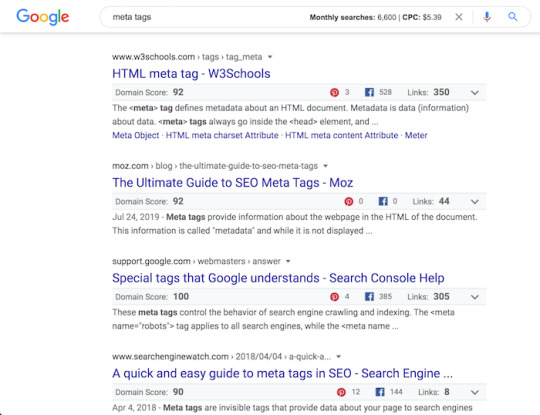
If you notice a web page with thousands of social shares and hundreds of links, it should reaffirm that you probably want to go after that term. And the listing that has thousands of social shares and hundreds of links is a good benchmark of a page that is high in quality and what people in your space prefer.
Ideally, you want to create something better than that one, as that is the main way you beat them over time.
Tool #6: Hello Bar
SEO is very different than paid traffic.
With paid traffic, you can drive people to a landing page with very little content, which makes it easier to generate sales or leads.
With SEO, Google prefers to rank content-rich sites.
But when someone lands on a page full of educational-based content, they are less likely to convert into a customer.
There’s a simple fix… Hello Bar.
Hello Bar has a lot of features, but I just want you to use the top bar like I do on NeilPatel.com.

And as you scroll it moves along with you.
That one little thing allows me to improve my conversion rate from my SEO traffic.
You can easily adjust what you show with a few simple clicks within Hello Bar or you can even show people different messages based on where they are coming from.

Although SEO traffic doesn’t convert as well as paid traffic, it is much cheaper in the long run and does have a better overall ROI. And that one little Hello Bar will improve your numbers.
It’s responsible for 9.4% of revenue from NeilPatel.com.
Every little bit adds up.
Tool #7: Mozcast
Google makes over 3,200 algorithm changes a year.
Are you really going to keep up to date with all of them?
If you followed the first tool and set up a project in Ubersuggest, you’ll get notified when your rankings go down.
And if you set up alerts in Google Analytics (tool number 2) you’ll also get notified when your traffic drops drastically.
What you’ll find is that it’s overwhelming to keep up with all of Google’s updates and it could be confusing to figure out what you need to fix to get your traffic back.
This report on Moz keeps track of all of the algorithm updates and gives you an overview of what has changed or what the update is about. On top of that, you’ll want to check out the Mozcast if you get a notification of ranking or traffic drops as this tool confirms if other people are also seeing changes from a Google update.

Keep in mind that Google doesn’t announce each update, hence you’ll want to cross-reference what you are seeing with the Mozcast.
That way you don’t have to spend hours researching each update.
Tool #8: Detailed
Link building is a pain. There are so many link tools like this one… but let’s not kid ourselves… you just don’t have the time to spend 10 to 20 hours a week doing link building.
So, each minute you spend, you have to make sure it counts.
There’s a tool called Detailed that breaks down the best links for every industry.
All you have to do is select an industry and a site and it shows you all of the good links that are going to your competition.
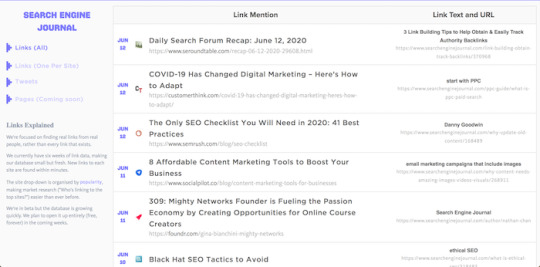
You can then focus your efforts on reaching out to those sites to get links.
Sure, you will still need to have amazing content or a good product or service in order to convince those sites to link to you, but hey, if you don’t have any of that it’s going to be hard to do well in the first place.
So, don’t waste your time trying to search for links when Detailed will give you a list of hundreds of amazing sites to get links from within your space.
Tool #9: Site Speed Audit
Speed impacts rankings.
Google doesn’t want to rank slow websites anymore.
It doesn’t matter that technology has become better and you can now purchase satellite Internet. Not every location has blazing fast Internet.
For that reason, Google has an Accelerated Mobile Pages framework that helps with mobile load time.
But that’s not enough, you also need your website to load fast.
So, go here and put in your URL.
You’ll then be taken to a report that looks like this:
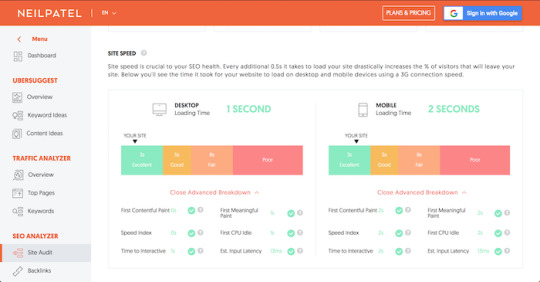
What’ll you want to focus on is site speed. That Ubersuggest report pulls from Google Lighthouse.
So, send that to your developer and tell them to get you in the green mark for both mobile and desktop load times.
As your speed goes up, so will your SEO rankings and traffic over time.
Tool #10: Supermetrics
Are you tired of having your data everywhere?
Why would you want to log into four of five different apps to get your SEO and marketing data when you could log into one.
And no, I am not talking about Google Analytics. I am talking about Google Data Studio.
If you haven’t used it yet, sign up for it… it’s free.

Google Data Studio is a business intelligence tool that will show you all of your data in one place.
So how do you get all of your SEO data into Google Data Studio? You use Supermetrics.
It passes all of your SEO data from different sources into Data Studio, so you no longer have to log into multiple tools, including Google Analytics.
My favorite feature in Supermetrics is you can automate your marketing reporting, so you no longer have to create your reports manually.
Tool #11: VidIQ
Google is the most popular search engine.
But do you know what the second most popular search engine is?
It’s not Bing… it’s actually YouTube, which Google actually owns.
If you haven’t done YouTube SEO yet, you should reconsider. Just look at how much search traffic I get from YouTube each month.
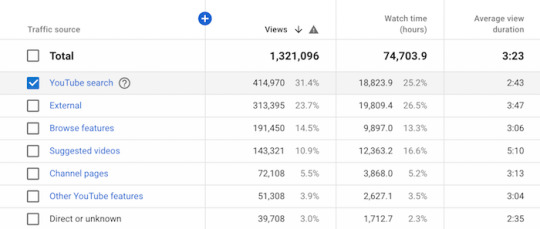
This article will break down how to do YouTube SEO if you want to learn how it works.
But to make things easier, install this Chrome extension.

Whenever you perform a search on YouTube it will show you what’s popular, what keywords are being searched that are related to each video, and which tags people are using to get more SEO traffic.
I wanted to end this post with VidIQ because it’s not competitive.
See, unlike traditional SEO, it doesn’t take months to see results. YouTube SEO is the opposite in which it isn’t as competitive (yet) and you can rank at the top within 24 to 48 hours of releasing a video (seriously!).
Conclusion
They say SEO is hard and time-consuming. And I am not going to lie, you won’t get results unless you put in some effort.
But who says it has to be as time-consuming?
By using some of the tools I mentioned above you’ll save time. It really is that simple.
I know there is a lot and it can be overwhelming. So if you don’t have time to use all of the tools it is fine… just start at the top and work your way down (I put them in order based on what will save you the most time).
What other ways do you save time on your SEO?
The post The SEO Tool Kit: 11 Tools That’ll Save You Time appeared first on Neil Patel.
Original content source: https://neilpatel.com/blog/seo-tool-kit/ via https://neilpatel.com
See the original post, The SEO Tool Kit: 11 Tools Thatll Save You Time that is shared from https://imtrainingparadise.weebly.com/home/the-seo-tool-kit-11-tools-thatll-save-you-time via https://imtrainingparadise.weebly.com/home
0 notes